A growing operation
SAEC member begins hydroponic farm

Stories | Recipes | Events | People | Places | Things | Local News
South Alabama Electric Cooperative
September 2023
 Manager David Bailey
Manager David Bailey
Produced by the staff of South Alabama Electric Cooperative
ALABAMA LIVING is delivered to some 420,000 Alabama families and businesses, which are members of 22 not-for-profit, consumer-owned, locally directed and taxpaying electric cooperatives. Subscriptions are $12 a year for individuals not subscribing through participating Alabama electric cooperatives. Alabama Living (USPS 029-920) is published monthly by the Alabama Rural Electric Association of Cooperatives. Periodicals postage paid at Montgomery, Alabama, and at additional mailing office.

POSTMASTER send forms 3579 to: Alabama Living, P.O. Box 244014 Montgomery, Alabama 36124-4014.
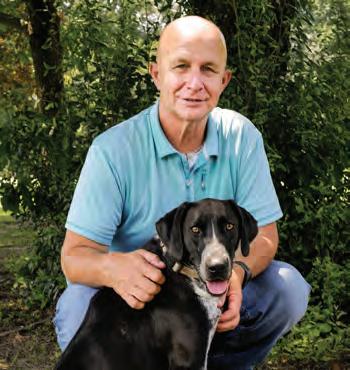
ALABAMA RURAL ELECTRIC ASSOCIATION
AREA President
Karl Rayborn
Editor
Lenore Vickrey
Managing Editor
Allison Law
Creative Director
Mark Stephenson
Art Director
Danny Weston

Advertising Director
Jacob Johnson
Graphic Designer/Production Coordinator
Brooke Echols
ADVERTISING & EDITORIAL OFFICES:

340 TechnaCenter Drive Montgomery, Alabama 36117-6031
1-800-410-2737
For advertising, email: advertising@areapower.com
For editorial inquiries, email: contact@alabamaliving.coop
NATIONAL ADVERTISING REPRESENTATIVE:
American MainStreet Publications 611 South Congress Ave., Suite 504 Austin, Texas 78704


1-800-626-1181
www.AMP.coop

www.alabamaliving.coop
USPS 029-920
5
See

54 VOL. 76 NO. 9 SEPTEMBER 2023 DEPARTMENTS 11 Spotlight 29 Around Alabama 44 Cook of the Month 42 Outdoors 43 Fish & Game Forecast 54 Cup o’ Joe ONLINE: alabamaliving.coop 30 SEPTEMBER 2023 3 WE WANT TO HEAR FROM YOU! ONLINE: www.alabamaliving.coop EMAIL: letters@alabamaliving.coop MAIL: Al abama Living 340 Technacenter Drive Montgomery, AL 36117 Sweet and savory The family of Quinton and Joni Harris all help with the operation of Kay-Bri Desserts and Southern Venue in eastern Wilcox County, which specializes in homemade cakes, cookies, muffins and cinnamon rolls, as well as weekend lunches and dinners.
ISSN
Printed in America from American materials Get our FREE monthly email newsletter! Sign up at alabamaliving.coop ON THE COVER Look for this logo to see more content online! FEATURES
•
1047-0311
Ready to serve
joins SAEC Board of Trustees representing District 2.
Vote, vote, vote! Annual meeting packets are on the way to members.
Enjoy a Cup o’ Joe Say hi to Joe Hobby, once a joke writer for Jay Leno, now our new humor columnist.
checks on a wall of romaine lettuce.
Bart Snyder
50
54
5 Wiregrass Roots owner Chase Flowers
story
Page 6.
Board of Trustees

Taking the big hit
David Bailey, General Manager







Remember Chuck Bednarik? As an Alabama fan, I know him because an award was named after him to honor the country’s best defensive college football player. An Alabama player has won it three times, and if it had existed before 1995, I suspect that number would be higher. For me, Derrick Thomas is probably the greatest defensive college player of all time.
Bednarik is most famous for tackling the New York Giants’ Frank Gifford with less than a minute left on the clock. With Bednarik’s rival Philadelphia Eagles leading, 14-10, and the Giants driving toward the end zone, Gifford caught the ball and looked downfield. Closing in from the sideline, Bednarik leveled him, knocking the ball free for the Eagles to recover the fumble. In a famous photo, Gifford is laid out on the field like a dead man while Bednarik pumps his fist and shouts, “This game is over,” albeit in slightly more colorful language.

What does all this mean for your cooperative? Let’s review some of the issues we’ve been facing since 2020. First is the supply chain. It can still take over a year to receive regular size transformers for our residential members. We need to pray that our country doesn’t have any major weather events because this would cause further delays and may extend power restoration time. Basic wooden utility poles can take three to eight weeks depending on the size, and meters can take nine months or more. This isn’t something we’ve dealt with before in our 85-year history but has been an issue over the past three years.
Now we’re facing a new challenge. It has to do with electrical steel, an iron silicon alloy essential for a variety of electrical machines from transformers to electric motors. You’ve probably heard about the big push toward electric vehicles. EVs need electrical steel for their motors, and there is an electrical steel
shortage in our country.
Currently, there is one domestic producer of electrical steel. Yes, I said one! In March, that manufacturer told the Department of Energy that scaling up steel production would not be easy or cheap. Meanwhile, two other manufacturers are working on increasing their electrical steel production, but the domestic supply is still likely to fall short of our needs.
So, what can we do? I always like to look back to history and I’m reminded of the late 1800s when Andrew Carnegie built the Carnegie Steel Company, turning the U.S. into the largest steel producer in the world. He later sold it to J.P. Morgan, forming the basis of the U.S. Steel Corporation and making the U.S. economy the strongest in the world. It’s a great example of capitalism.
I say let’s let capitalism work. Slow down unrealistic regulations and ease the mandates pushing for all vehicles to be electric by a set year. If they really are the next big thing, the consumer will make that clear.
In the meantime, your electric cooperative’s main focus is providing our members with reliable, safe and affordable electricity. That includes meeting the needs of our growing community without being hamstrung by long wait times for essential equipment.
My hope is that we aren’t out of the game like Frank Gifford just yet. He missed a whole year of football recovering from the vicious hit he took from Bednarik. I know electric cooperatives will overcome these issues and serve our members. With fewer regulations and more government action like the Rural Electrification Act that established this cooperative, we’ll be ready to march forward. Lastly, Bednarik was a great American serving his country in WWII as a B-24 waist gunner.
Until next month, be safe.
4 SEPTEMBER 2023 www.alabamaliving.coop
Tim Sanders District 7
James May Vice President At Large
Douglas Green Secretary/Treasurer District 6
Delaney Kervin President District 5
Bart Snyder District 2
Johnny Garrett District 1
Raymond Trotter District 3 Ben Fox District 4
Bart Snyder joins SAEC board as District 2 trustee
Bart Snyder says the three things he finds most important in life are faith, family and friends.
The longtime Goshen High School football coach was officially appointed to the South Alabama Electric Cooperative’s Board of Trustees as the District 2 representative at the July board meeting. He replaces Jimmy Shaver, who passed away in March after serving as a trustee for 41 years.
Snyder considers the Goshen community part of his family and says it’s a privilege to be able to serve on the SAEC Board of Trustees. “I want to learn and be the best I can be for our members,” he says.
As a lifelong Goshen resident, he made an impact on countless lives in his community as a coach, teacher and mentor. But, he says an experience in the mid ’90s is what really ignited a fire in him to be part of SAEC.
Teachers participated in a program that allowed them to job shadow different industries during the summer. Snyder went to SAEC and spent time with employees in different departments — from going out in the field with line crews and engineers to observing management. The experience left a lasting impression on him.
“I thoroughly enjoyed the time I spent there, and I’ve always wanted to be part of it. SAEC represents the best people,” he says.
During his 34-year tenure on the sidelines at Goshen High School — 12 of those years as head coach — he became the winningest coach in Goshen football history with a 74-55 record. He also led the Eagles to the state semifinals in 2017.
Although he retired from coaching earlier this year, Snyder has plenty of interests to keep him busy, including tending the cattle on his Fox Burrow Farms. He credits his father and grandfather for his love of the
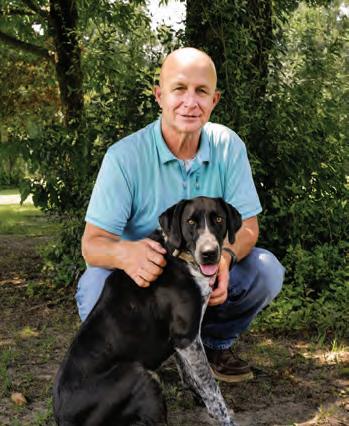
outdoors. The land he currently lives on has been in the Snyder family for over 100 years.
As a painter, he enjoys different media like watercolors and acrylics. He can often be found painting the Goshen High School football field, which he has been doing since the late ’80s. “Art has been a good way of helping me relieve stress,” he says.

Snyder is an active member at Little Oak United Methodist Church in Goshen, and although he is no longer on the Goshen High School sidelines, he can be heard announcing local high school football games on Troy’s WTBF.
Spending time with family is a high priority for Snyder. He and his wife, Stephanie, just celebrated their 27th wedding anniversary. “I may never win the lottery, but I won more than that when she said yes,” he says.
The couple has two sons, Will and Brock, and a daughter-in-law, Masey. Will is currently studying at Troy University, and Brock is in medical school at Auburn University.
Mailing address
P.O. Box 449 Troy, AL 36081
Phone 334-566-2060
800-556-2060
Website www.southaec.com
Find us here: Tf
Payment Options
SAEC Connect
Available from the App Store and Google Play
BY MAIL
P.O. Box 449 Troy, AL 36081
WEBSITE
www.southaec.com
PHONE PAYMENTS
877-566-0611, credit cards accepted
NIGHT DEPOSITORY
Available at our Highway 231 office, day or night
PAYMENT POINTS
Kiosk in office lobby
Regions Bank - Troy branch
Troy Bank and Trust - all branch locations
1st National Bank of Brundidge and Troy
First Citizens - Luverne branch
Banks Buy Rite - Banks
Country One Stop - Honoraville
IN PERSON
13192 U.S. Hwy. 231, Troy, AL 36081
Office Hours: Monday-Friday, 8 a.m.-5 p.m.
Questions?
For questions concerning Capital Credits, contact: capital.credits@southaec.com.
For questions concerning Billing, contact: billing@southaec.com.
For questions concerning Construction, contact: construction@southaec.com.
Alabama Living SEPTEMBER 2023 5
Information £ ¤ 331 £ ¤ 29 £ ¤ 29 £ ¤ 29 £ 331 £ ¤ 231 LOWNDESMONTGOMERY BULLOCK BARBOUR DALE COFFEE CRENSHAW PIKE COVINGTON BUTLER Honoraville Highland Home Petrey Luverne Glenwood Brantley Springhill Troy Goshen Shellhorn Shady Grove China Grove Saco Josie Banks Brundidge New Hope Victoria Jack Henderson SAEC Service Area SAEC Service Area
Contact
Bart Snyder’s many hobbies include painting.
New SAEC Board of Trustees member Bart Snyder enjoys spending time outdoors with his dog, Tikka.
TAKING ROOT
SAEC member turns to hydroponic gardening
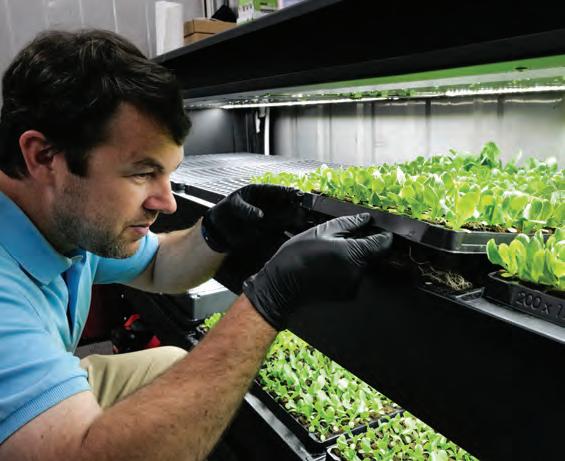
Chase Flowers has always had a passion for watching things grow.
“It goes back to my childhood watching my dad farm row crops,” he says.
Farming is in his blood. Flowers grew up with fond memories of working on the family farm in Brundidge.
Treasured childhood memories include having to jump on top of loads of cotton in the summer heat to help compress them into the truck and helping his dad, James Flowers, hook up the dryer to the peanut wagon.
After some difficult years for crops, Flowers’ father decided to take a job at South Alabama Electric Cooperative, where he is now the service superintendent.
Even though things had changed for the family, farming was never far from Chase Flowers’ mind. He loved everything about it — well, almost everything.
“What I realized is that while I have always loved growing things, what I hated was the heat,” Flowers says.
He wanted to find a way to do what he loved while making it more enjoyable and attractive for his four children to get involved without spending long days in the sweltering south Alabama heat. He found a solution in hydroponic gardening, and that’s how Wiregrass Roots came to be.
Wiregrass Roots is a vertical hydroponic operation Flowers started in November 2022, on his family’s Wildflowers Farm,
ing, plants are grown in water instead of by planting roots in soil. Plants receive the essential nutrients they need to thrive via water-soluble fertilizers through a process known as fertigation.
After researching some options, Flowers began with a very basic setup. He also reached out to the horticulture department at Auburn University for guidance and information. “Once I got more information and learned the ins and outs of hydroponics, I fell in love,” he says.
The process
Flowers can grow any type of leafy greens inside the 8-by-40-foot trailer, but his most popular veggies are romaine and butter lettuce. The trailer is outfitted with state-of-the-art equipment that monitors water intake and carbon dioxide.

LED lights are programmed to mimic sunlight and are set to go dark from 3-9 p.m. to simulate the sun setting and nighttime. When the lights are on during the day, the temperature is a constant 70 degrees, and when they’re off, the temperature drops to 66 degrees.
which is also a poultry and beef operation. Instead of traditional farming with row crops outdoors, Wiregrass Roots’ produce is grown indoors, avoiding problems related to weather and pests.
“I’ve always been curious about nature, and I love the idea of hydroponics,” Flowers says.
In hydroponic garden-
“With the lettuce being in the controlled environment, it allows me to provide a good quality product to the public. We don’t have any pest problems because they’re in a sealed area, and we also don’t have problems losing produce because of rot,” he says. This is also a year-round operation. Because lettuce is a coolweather crop, it would be extremely difficult to grow in the south Alabama heat.
On average, Flowers says it takes 5 gallons of water each day to produce 1,000 heads of lettuce per week.
Each head of lettuce begins as a seed that is placed in a tray in the nursery area. Tables are flooded and then drained every nine hours with nutrient-rich water, and
6 SEPTEMBER 2023 www.alabamaliving.coop
Wiregrass Roots is located in a freight container on the Flowers family property in Brundidge.
Chase Flowers monitors the next batch of romaine lettuce.
the coconut liner absorbs those nutrients so the seed can germinate. Seeds stay in the nursery area for three weeks before they’re transplanted to the cultivation area.
The cultivation area consists of strips of foam attached vertically to the walls of the trailer. The plugs are placed in the foam so the root system can develop and get stronger. This is the final stage until harvest and typically takes around four weeks.
While having the hydroponic operation relieves some of the traditional stresses

of farming, Flowers and his wife, Claire, enjoy sharing the wonder of growing produce with their daughters MJ, Isla, Georgia and Margo. While the girls aren’t quite old enough to do the heavy lifting yet, they generally help out by planting the seeds during the first step.
“Farming is vital to our area and our country,” says SAEC General Manager David Bailey. “Farmers played a vital role in the formation of electric cooperatives like South Alabama Electric. We are proud that Chase is looking to the future and
ensuring that the tradition of farming is successful.”
Flowers has big plans for the future of Wiregrass Roots. “We are planning on branching out and growing other products like microgreens,” he says. Currently, the business’s produce can be found at Grocery Outlet stores in the Wiregrass area and Renfroe’s Market in the River region.
To learn more about Wiregrass Roots and the progress the business is making, visit its Facebook page.
Alabama Living SEPTEMBER 2023 7
Flowers uses red and blue LED lights to maximize plant growth.
Ballots must be received before Oct. 30. Please allow sufficient time for mail delivery.


Be sure to vote!
NOTE: Only one vote per membership is allowed.
It’s time
Voting packets for the 2023 Annual Meeting will be arriving in South Alabama Electric Cooperative members‘ mailboxes at the end of this month.
to
you can
your
in just a few simple
Step 1 Open the envelope and read all the instructions. ELECTION BALLOT ENCLOSED Step 2 Make your candidate selection by filling in the box next to your choice. Step 3 Place the completed ballot in the enclosed return envelope. CANDIDATE BIOS Step 4 Mail your ballot to Alabama Electric Cooperative District Election Ballot vote!
Members who vote by mail will receive a $20 bill credit. Your voice matters. Once your voting packet arrives,
cast
ballot
steps:
8 SEPTEMBER 2023 www.alabamaliving.coop
University of West Alabama covered bridge. Students walk through it between residence halls and classroom buildings to get to the student union.
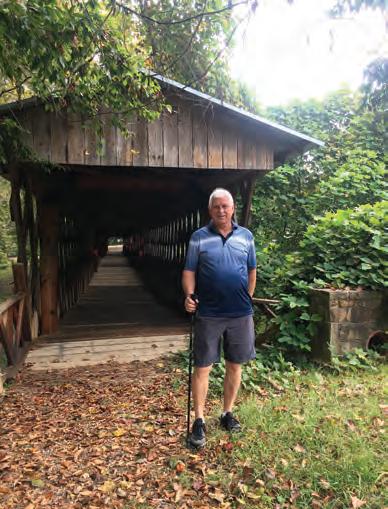
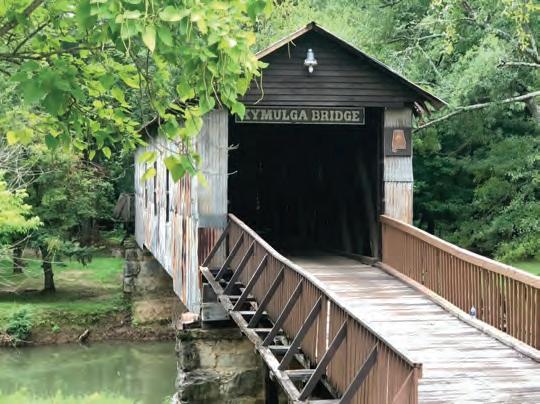
Our family’s red covered bridge. SUBMITTED by Peg Watson
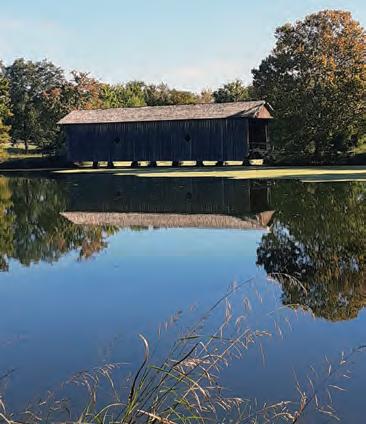


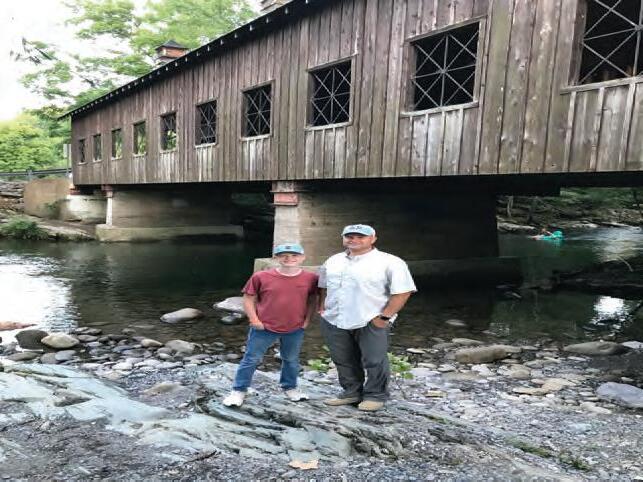
November theme: “Lost my first tooth” | Deadline: September 30
SUBMITTED by Tammy White, Hartselle. Online: alabamaliving.coop | Mail: Attn: Snapshots, P.O. Box 244014, Montgomery, AL 36124
RULES: Photos submitted for publication may also be published on our website at alabamaliving.coop and on our Facebook and Instagram pages. Alabama Living is not responsible for lost or damaged photos. Send a self-addressed stamped envelope to have photos returned.
Phenix City.
Robbie and Trace Turner at Emert’s Cove Bridge in Gatlinburg, TN.
SUBMITTED by Misty Turner, Sylvania.
My wife, Sheree, and me at Swann Covered Bridge in Blount County. SUBMITTED by Tim Powell, Tallassee.
Roland Postler visiting Clarkson Covered Bridge near Cullman, AL. SUBMITTED by Nancy Postler Dothan.
| Alabama Snapshots | Alabama Living SEPTEMBER 2023 9
Kymulga Covered Bridge in Childersburg, AL.. SUBMITTED by Jeanna Bulman, Orange Beach.
Smithsonian exhibit comes to Alabama this fall
The “Crossroads: Change in Rural America” exhibit begins its five-town tour of Alabama on Sept. 14, with a grand opening in Cleveland, in Blount County. Over 2023-2024, “Crossroads” will also visit White Hall in Lowndes County, Roanoke in Randolph County, Triana in Madison County and Ozark in Dale County.

The exhibit looks at the remarkable evolution in rural life over the past century and explores how Americans have responded and adapted. The exhibition will prompt discussions about what happened when America’s rural population became a minority of the country’s population and the ripple effects that occurred. The exhibit is a partnership between the Alabama Humanities Alliance and the Smithsonian’s Museum on Main Street program. Visit alabamahumanities.org
Send us your photos from the stands!
Are you a die-hard fan of the Friday night lights? Are you ready for your favorite high school team to take to the court later this fall? Then we need your help!
The Electric Cooperatives of Alabama are proud sponsors of this year’s Alabama High School Athletic Association’s 2023 Super 7 Football Championship and the 2024 Boys and Girls Basketball Championships, which will air live on Alabama Public Television.

We’d like you to send us some great photos of your friends and family cheering on your favorite team, or just a photo from the perspective of watching the game from the stands. We may use your photo in a commercial!
Visit alabamaliving.coop to send us your photos.
Entries sought for Zelda Sayre Fitzgerald Young Writers Award
The Fitzgerald Museum’s third annual Zelda Sayre Fitzgerald Young Writers Award is accepting submissions of portfolios from young writers currently attending high school (grades 9 –12) in Alabama.
Submissions will be accepted from Sept. 1 until Dec. 31. Each student may only enter once. Portfolios should be submitted through the web form on the Fitzgerald Museum’s website, thefitzgeraldmuseum.org. Questions should be directed to coordinator Foster Dickson at fitzgeraldliterarycontest@gmail.com, with “Zelda Fitzgerald Award Question” in the subject line. Portfolios should contain literary works (stories, poems, plays or film scripts, multi-genre works) totaling 5 to 15 pages. Works may include artwork, illustrations, font variations, and other graphic elements.
Montgomery, Alabama native Zelda Sayre Fitzgerald was daring and revolutionary in her life, art, and writing, and the Young Writers Award seeks to identify and honor Alabama’s high school students who share her talent and spirit. Zelda Sayre Fitzgerald was inducted into the Alabama Writers Hall of Fame in spring 2020.
Find the hidden dingbat!
Searching for last month’s dingbat, a vinyl record, was apparently quite enjoyable for many of our readers who took the time to write or email us. Laura Leigh Wright says, “I am a collector of vinyl since I inherited my Dad’s collection when he passed away. This was a fun one to search for!” Savannah Engelking says she found the dingbat (it’s a magnet on the refrigerator in the photo on Page 38), which she described as “such a cheeky spot that I never would have thought to look there! Thanks for keeping fun activities for us to do because some of us look forward to it!” James R. Warren of Gulf Shores wrote us that he was glad to participate in the contest “especially since the most observant participants seem to be children, and I am 88 years old.” Searching for the record album took Itylene Benedick of Jack, a member of South Alabama Electric Cooperative, down memory lane. “I always enjoyed the vinyl records…they were so popular when I growing up and in adult life…the dingbat brought back many memories for me.”
And Michelle Cobb of Louisville, a member of Pea River EC, said she found the dingbat the first time looking through the magazine when she spied the photo of the child with the refrigerator door open, “a big pet peeve for me.” But she was happy to find the vinyl frig magnet, so then she could “relax and read the articles, which I noticed several had caught my attention.” That’s the idea, Michelle!
Congratulations to Michelle Turvin of Dothan, a member of Wiregrass EC, for being our randomly drawn winner this month. She wins a gift card from Alabama One Credit Union. This month, we’ve hidden a treasure chest in recognition of International Talk Like a Pirate Day, Sept. 19. Good luck!
Sponsored by
By mail: Find the Dingbat Alabama Living PO Box 244014 Montgomery, AL 36124
 By email: dingbat@alabamaliving.com
By email: dingbat@alabamaliving.com
10 SEPTEMBER 2023 www.alabamaliving.coop Spotlight | September
The Smithsonian traveling exhibit will highlight change in rural America over the past century.
Whereville, AL Take us along!


We’ve enjoyed seeing photos from our readers on their travels with Alabama Living! Please send us a photo of you with a copy of the magazine on your travels to: mytravels@alabamaliving. coop. Be sure to include your name, hometown and electric cooperative, and the location of your photo.We’ll draw a winner for the $25 prize each month. Make sure your photo is clear, in focus and not in shadow.


Identify and place this Alabama landmark and you could win $25! Winner is chosen at random from all correct entries. Multiple entries from the same person will be disqualified. Send your answer with your name, address and the name of your rural electric cooperative, if applicable. The winner and answer will be announced in the October issue.
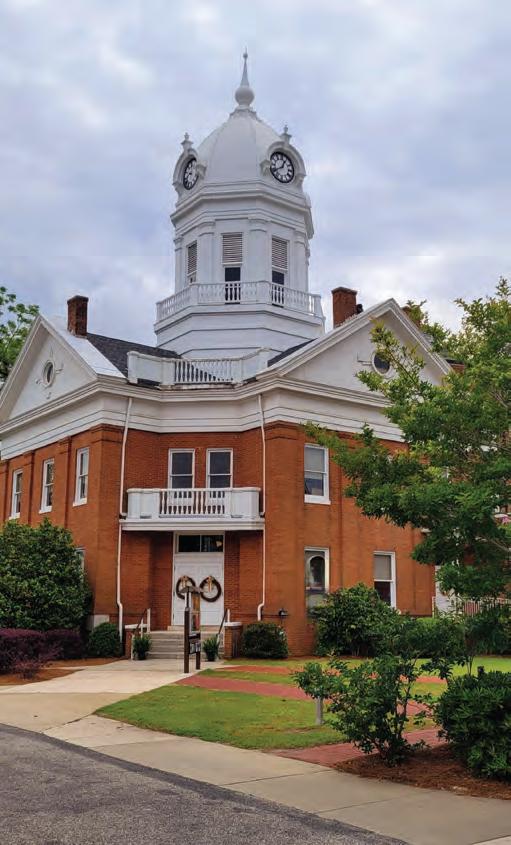
Submit by email: whereville@alabamaliving.coop, or by mail: Whereville, P.O. Box 244014, Montgomery, AL 36124.


Do you like finding interesting or unusual landmarks? Contribute a photo you took for an upcoming issue! Remember, all readers whose photos are chosen also win $25!

August’s answer: The Ronald McDonald boll weevil statue – known as “Ronald McWeevil” –is part of a collaborative community art project in Enterprise. This happy fellow – with enough arms to carry a happy meal, fries, drink and one arm empty – stands in front of the McDonald’s restaurant on Boll Weevil Circle. The Wiregrass has several public artworks dedicated to the history of the pest, which devastated the area economy but also allowed for the diversification of agriculture. (Information from WTVM) (Photo by Lenore Vickrey of Alabama Living) The randomly drawn correct guess winner is Bridgett Hilley of Marshall-DeKalb EC.

Alabama Living SEPTEMBER 2023 11 September | Spotlight
Jane and Jerome Kendrick of Cropwell, members of the Coosa Valley Electric Cooperative, visited the Fairmont Banff Springs Hotel in Banff, Canada, last summer.
Jeffrey Walker of Baker Hill sent us this photo from a trip to Alaska, requested by his girlfriend Danielle’s daughter, Lana, via the Make a Wish program. Walker, a member of Pea River EC, took his magazine on board the Glacier Quest where they cruised the waters of Prince William Sound to visit glaciers and view wildlife.
Tisha Lemons, a member of Arab EC, took her magazine along on a trip to Cheyenne, Wyoming.
Linda Jackson has been waiting patiently for us to run this photo of her and her daughter-in-law, Mandy, and granddaughters Laurel and Ella when they traveled to New York City and saw the fireworks on the East River. She’s a member of Dixie EC.
Lynne Brown of Foley, a member of Baldwin EMC, sent us this photo of her grandson Will Helms, taken with the “Peachoid” water tower in Gaffney, South Carolina.
Friends Rayford and Judy Edmondson, Mary (Penny) Nicholls, and James Bolton of Wedowee, traveled to Icy Point, Alaska with Alabama Living. They are all members of Tallapoosa River EC.
2023 Alabama Living
Once again, the annual Alabama Living photo contest generated a wealth of good photos from our readers – and this year also saw the most entries. More than 330 photos made it into our contest, and we couldn’t be more pleased!

The categories this year, as advertised in the magazine, were Nature, At Play (sports, recreation, having fun) and Alabama Travels. We received so many entries in the Nature category (more than two times as many as the other two categories combined), we decided to split the Nature category into two: Nature – scenery, and Nature – animals and insects.
As in past years, photographers were limited to two photos per category; that includes the Nature
Nature – scenery 1st Place
category (we did not allow four photos in that split category, since we could not re-advertise that distinction).
Each first-place winner will win $100, and those as well as the honorable mentions are shown in the following pages. A big thank-you to all the great amateur photogs who entered this year.
Our judge again this year was Julie Bennett, an award-winning photojournalist based in central Alabama. She is on staff at the Media Production Group at Auburn University and teaches photojournalism in the College of Liberal Arts. She has also taken several photos for Alabama Living. (She did not know the identities of the entrants.)
Mike Benton, Baldwin EMC
Judge’s comment: There is something so serene about this image. I love the composition, the leading lines and the framing. Super nice light with the sunset and a great use of exposure here.
Living photo contest


Celeste Collier
North Alabama EC
Judge’s comment: Beautiful colors here. I love the composition – the lines in the photo bring your eye to people.

Honorable Mention
Cheree Caudle, Livingston, Ala.
Judge’s comment: The details and the colors here are gorgeous. Kudos on the exposure and the edits.
Honorable Mention
Troy Beshears
Anniston, Ala.
Judge’s comment: Wow, what a beautiful scene. Nice work on the exposure that really captured it.
Honorable Mention
Alabama Living SEPTEMBER 2023 13
Nature – animals and insects 1st Place

Sandra Kiplinger, Arab EC
Judge’s comment: This was a super difficult category. Not only were there a lot of pictures, but there were a lot of really good ones. The timing of this photo is magnificent. I love how up-close and personal we are with the dolphin.

Meredith Crigler, Baldwin EMC Judge’s comment: This photo is so captivating. The shallow depth of field between the foreground and background make this look like it was shot for a movie.
Honorable Mention
David Adams, Pioneer EC Judge’s comment: There are quite a few interesting photos of birds, but this one stands out to me because of the composition and repetition of the branch through the frame. Also, the isolation of the bird is notable.
Honorable Mention

14 SEPTEMBER 2023

At play
Ashley Bass, Eclectic, Ala. Judge’s comment: Super creative photo: I can’t help but want to know more about it. That young lady seems very proud of her harvest and what an interesting way to show it off.

Honorable Mention
Judge’s comment: This is such a sweet moment. The light from the sunset coupled with the ocean waves make the scene memorable.

Honorable Mention
Judge’s comment: I love the composition of this photo! The colors and the reflection on the water bring your eye right back up to the fishing boat in silhouette. It’s such a peaceful capture with the fog in the distance and the still water in the foreground.
1st Place
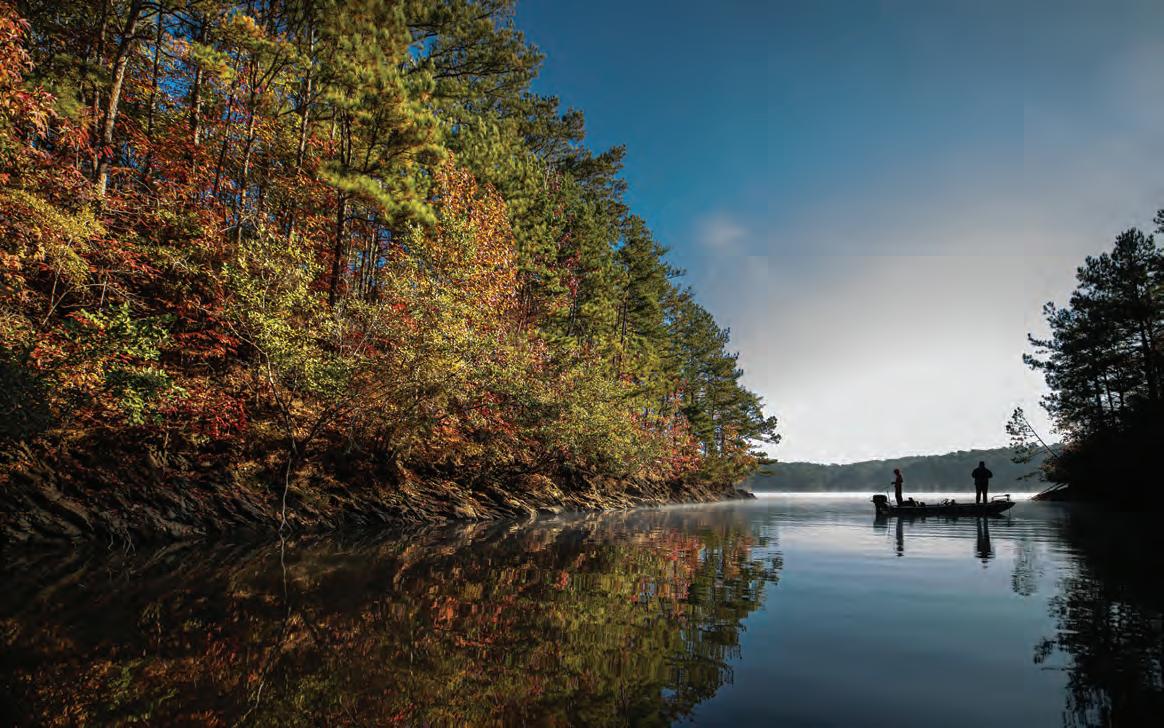
www.alabamaliving.coop
Troy Beshears, Anniston, Ala.
Michael Swindle, Baldwin EMC

Alabama Travels
1st Place
Troy Beshears, Anniston, Ala.
Judge’s comment: Fireworks can be tricky to shoot with the long exposures required to capture them correctly, but the photographer really nailed this one.

Cayce Willis, Trinity, Ala.

Judge’s comment: Love the composition of this! Great decision by the photographer on the crop of the shadows; they make it so much more interesting.
Anjana Henry, Joe Wheeler EMC
Honorable Mention Honorable Mention

Judge’s comment: I can tell a lot of work went into this. Nice use of a long exposure to capture those stars.

Alabama Living SEPTEMBER 2023 19
The state of Alabama’s oysters
Consumer demand drives growth of oyster industry
By Jennifer Kornegay
For most people, there’s not much middle ground when it comes to oysters: You either really like them or you really don’t. And for true oyster fans, the mollusks are more than a meal; they’re an experience, often served at special celebrations and ordered time and time again at favorite restaurants. But whether you consider the bivalve beloved or “bleh,” in Alabama, they’re a seafood staple.
Wild wonders
In Alabama, we harvest and eat one species of oyster: the Eastern Oyster (Crassostrea virginia). But there are two sources of these oysters: wild stock and farms. For the first population, recent years have yielded good news. Following major hurricanes like Ivan (2004) and Katrina (2005) and then years of drought that dropped water salinity levels, the number of wild oysters in Alabama waters plummeted.
“Low salinity means less oysters spawning and more oyster predators, like the oyster drill,” says Col. Scott Bannon, director of Alabama’s Marine Resources. In 2019, the state didn’t even have a harvest season; the status of oysters was that bleak. But then, they made a comeback.


According to Bannon, wild oyster numbers are now on the upswing, evidenced by his department’s seasonal surveys. “I’m hopeful that this season’s results will be similar to the last few years, which have been trending positive thanks to conditions getting right again,” he says. This means more oysters for eating and
and sell them.
Farm fresh
The number of farmed oysters being grown in Alabama waters is also on the rise. As late as 2009, there were zero oyster farms in Alabama; today, there are approximately 17. Like more robust wild populations, a growing oyster farming industry also means more jobs and a boost for coastal communities’ economies. Plus, these “boutique” oysters are not in competition with the wild stock; they complement it. They are a different product, raised with emphasis on taste and appearance, and most often enjoyed on the half shell, either raw or dolloped with butter and seasonings before being roasted.
Off-bottom oyster farming (also called oyster aquaculture) is the method used by most Alabama oyster farms and differs from raising livestock on land. While farmers do control some aspects of their “crop,” they aren’t feeding them or medicating them. They’re simply protecting them as they grow.
Like most farming, cultivating oysters starts with seed — tiny baby oysters that have been collected from mature oysters after they spawn in facilities called hatcheries. Once in the hands of one of the state’s oyster farms, these still-growing oysters go into the water of Alabama’s coastal bays and inlets, either in baskets strung from lines attached to pilings or in floating cages.
At this point, each farmer uses his own specific methods to tend
Closeup of an Alabama farmed oyster.
to his oysters. They may rest in different depths of water, which can impact taste, thanks to ranges in salinity and available food sources. The baskets or cages are turned at different intervals to manipulate the oysters’ cup size (the depth of the shell), which influences the shape of the meat inside and its texture. (Some farms remove the oysters from their baskets and tumble them in a machine to enhance this effect.) Moving the baskets also allows farmers to keep the shells free of barnacles and other pests than can, at worst, harm the oysters and at best, take away from the shells’ natural, unblemished beauty.
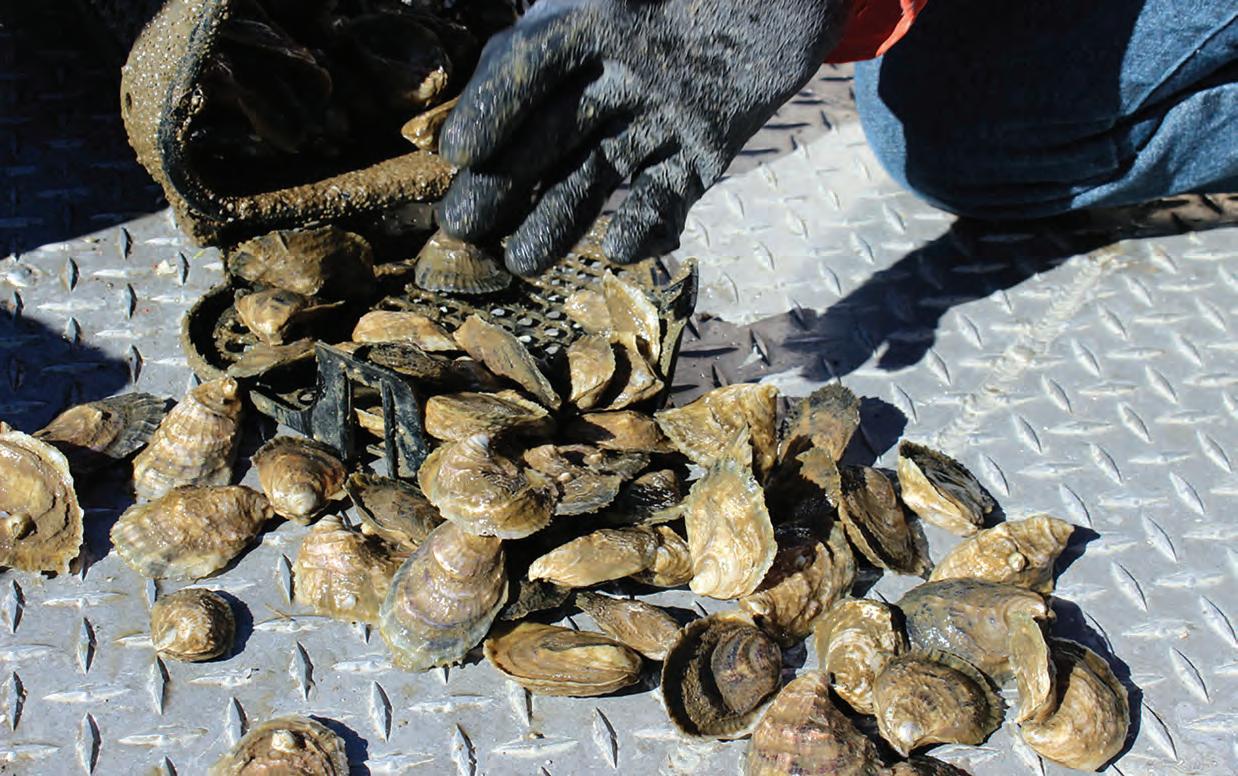
The bump up in the number of oyster farms and in the amount of oysters they’re growing is in direct response to heightened consumer demand, says Andrea Tarnecki, Ph.D., an assistant extension professor at Auburn University’s Shellfish Lab. “We’ve been increasing the numbers of farmed oysters harvested as well as their value,” she says.
feet wet, as well as a more streamlined permitting process and resources like alaquaculture.com. “There has been a lot of effort made by state agencies and others to provide training programs, and Alabama’s Marine Resources is supportive of farming,” she says.
One of the oldest and largest oyster farms in Alabama is Murder Point, run by the Zirlott family. They’ve long pulled a living from the Gulf, working as shrimpers, but in 2013 they diversified into oysters and chose the name based on a legend surrounding the farm’s location in Sandy Bay.

“Decades ago, they say a guy killed someone over oyster harvesting rights in this area,” says Lane Zirlott. “And now we say ours are so good they’re worth killing for.”
They may not bring anyone to actual violence, but they are popular, with diners asking for them by name at restaurants around the Southeast and now buying them direct from Murder Point’s two
Showing off the cleaner (non-barnacle-encrusted) shells of some Alabama farmed oysters, pulled straight from their basket that was suspended in the water.
the market being saturated. “There’s plenty of demand for all the oysters,” he says.
Navy Cove Oysters is also expanding and even offers farm tours to local visitors. Co-owner Chuck Wilson echoed Zirlott. “Alabama has huge potential for farm production and coincident restoration of oyster-elated ecosystem services. The farming community needs to work with state regulators to help that grow,” he says.
Big benefits for all
Lots of oysters — farmed and wild — are not just good for eaters and economies; oysters are key to healthy waters, as Bannon explains. “They are food sources for other species. I call them foundational critters, and they are a vital part of our Gulf ecosystem,” he says. Oyster farms bring additional environmental benefits. Their setups create homes for other marine life, and since oysters are filter feeders, more oysters in the water means more little filters cleaning it; adult oysters filter, on average, approximately two gallons per hour.
Tarnecki agrees and points to the work she and the Shellfish Lab are doing to help. “There’s research going on now to identify best practices for oyster reef restoration and conservation of other coastal habitats, which improves overall water quality,” she says. “There are also efforts in the Gulf working to breed oysters that are more resilient to environmental changes and disease. We have several research projects looking at that right now.”
Aw, shucks!
The populations of both Alabama’s wild and cultivated oysters are strong, but there are challenges facing both. Reefs resting in areas of low dissolved oxygen are a problem for wild oysters.
“We’re trying to solve that, creating some high spots for oysters to set to see if they’ll survive better elevated where there is more oxygen,” Bannon says.
He and his team are also helping oyster harvesters become more efficient with an improved oyster management system. “We’ve divided areas into grids, and harvesters can use their smart phone to see which are open or closed,” Bannon says. “It helps us monitor reef health and helps them find the grids that haven’t been hit as hard, maximizing their chances for a good haul.”
For oyster farmers in Alabama, one hurdle is access to quality farming areas. Marine Resources is hoping to partner with Alabama’s state lands division for a fix. “We’d like to allow folks to bid on and lease sections of state property to get the riparian (oyster harvesting or growing) rights off those lands to open up more spots,” Bannon says. “There is potential for more successful oyster farming in Alabama — the demand is there — but we have other issues too, like not enough oyster seed.”

This problem is why Murder Point’s operation is now fully integrated; it has its own hatchery to supply its farm with seed. But it’s not the number one challenge for farmers, according to Zirlott. “Some people still don’t really get what farmed oysters are, and others are still worried about eating oysters raw or eating them in certain months,” he says.
While immune-suppressed people should always be cautious about any raw food, Zirlott stresses how today’s refrigeration technology and strict industry regulations have made the consumption of oysters safer than ever. “It’s just not like the old days,” he says. “And we never cut corners in safety or quality.”
Bannon praises the quality of all Alabama oysters. “I travel around and have tried oysters from all over the country,” he says. “I like our Gulf Coast oysters better than any I’ve had.”
All this oyster info making you hungry? Two oyster-centric events are on Alabama’s autumn agenda.
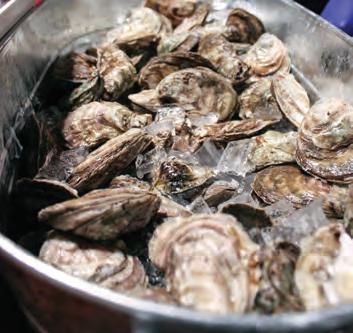
Montgomery Oyster Festival, 3-7 p.m., Sept. 16 in Montgomery, Old Alabama Town. Check Facebook for details and ticket info.
Experience the Oyster, Nov. 3-4 in Gulf Shores, hangoutcookoff.com
Both invite you to eat your fill of Gulf-farmed oysters. Try them raw and “naked” or sample cooked-oyster creations from some of the South’s best chefs.
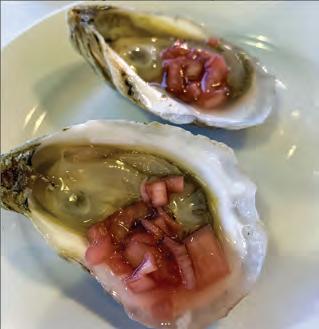 Harvesting wild oysters in Alabama waters with the tonging method.
Harvesting wild oysters in Alabama waters with the tonging method.
Eat ‘em up
PHOTO COURTESY OF MARINE RESOURCES DIVISION

Alabama Living SEPTEMBER 2023 23
Alabama Bookshelf
In this periodic feature, we highlight books either about Alabama people or events, or written by Alabama authors. Summaries are not reviews or endorsements. We also occasionally highlight book-related events. Email submissions to bookshelf@alabamaliving.coop. Due to the volume of submissions, we are unable to feature all the books we receive.

The Unsettled, by Ayana Mathis, Knopf, $14.99 (cultural heritage) This multi-generational novel is set in the 1980s in racially and politically turbulent Philadelphia as well as the tiny town of Bonaparte, Alabama, a Black community whose legacy and land a grandmother is fiercely trying to defend from White developers. The novel is about looking for a place to belong, having and losing land and what it means for a fractured family in America, according to the author.

Coastal Alabama Alphabet, by Rebecca M. Giles and Karyn W. Tunks, Brother Mockingbird, $21.99 (picture book/nonfiction) People, places, and events from Grand Bay to Orange Beach all make lower Alabama unique. Rhymed verse and interesting facts are paired with illustrations and work by local artists to highlight the distinct features of the area. The book also promotes learning with a hidden picture activity and glossary.

Memories of a Tuskegee Airmen
Nurse and her Military Sisters, by Pia Marie Winters Jordan, University of Georgia Press/ NewSouth Books, $29.95 (women’s history)

Air Born, by Jan Davis, Ballast Books, $29.99 (aviation/history)

Ben Smotherman, a B-17 pilot in World War II, was shot down over Holland in 1943 and was a prisoner of war for 21 months. Years later, after perusing his wartime log, his daughter, Jan Davis, made discoveries about her father’s experiences that shed light on her own life path. Davis is a space shuttle astronaut, flew NASA jets and completed three spaceflights, with more than 674 hours in orbit. She is also a member of North Alabama EC.
The Archaeology of Protestant Landscapes, by Kimberly Pyszka, University of Alabama Press, $49.95 (Alabama history) Part of a series titled The American South: New Directions and Perspectives, this work focuses on three religious institutions in the U.S. South in the 18th and 19th centuries, including St. Luke’s Episcopal Church in central Alabama. The author uses three case studies to highlight the social roles that religious organizations played in the development of communities.

The book focuses on the two dozen or so Black women, graduates of nursing schools throughout the country and lieutenants in the Army Nurse Corps, who staffed the station hospital on the base where the famed Tuskegee Airmen were undergoing training. The Airmen were not the only ones making Black history during World War II, the author found; these nurses had to fight gender as well as racial discrimination.
Five Points South: Poems from an Alabama Pilgrimage, by Nancy Owen Wilson, Kelsay Books, $20 (poetry)
A memoir written in poetic format, the book chronicles a road trip by the author, in which she revisits the places, characters and events of her heartland. She tackles difficult subject matter, including race and the legacy of slavery, but readers will likely come away with a feeling of hope.


GENERATOR SAFETY
Protect your family against carbon monoxide poisoning
Firing up one fuel-powered portable generator produces as much carbon monoxide (CO) as hundreds of combustion-engine cars, according to the Consumer Product Safety Commission.
Using a portable generator in a home, garage or too close to an enclosed area is like starting a parking lot full of cars and letting the CO poison seep into that area. The devastating result is almost immediate: The CO from one generator can kill in minutes.
CO facts
• CO is colorless and odorless. Poisoning can happen so quickly that exposed persons may become unconscious before recognizing any symptoms.
Each year in the U.S.:
• Approximately 85 individuals die from CO poisoning.
• Most deaths (81%) occur in residential locations.
• African Americans are at greater risk of CO poisoning, accounting for 23 percent of generator-related CO deaths, nearly double their estimated 13 percent share of the U.S. population, according to the U.S. Census.
Using a portable generator safely:
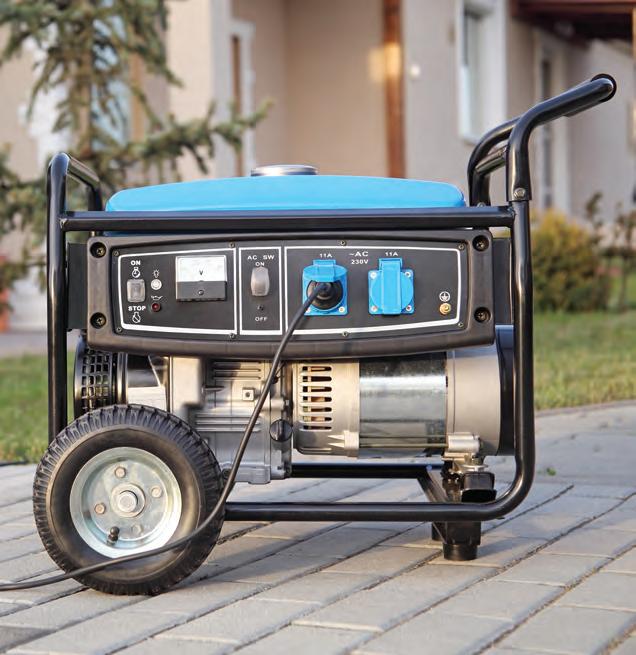
• Always use a portable generator at least 20 feet away from your home.
• Never operate one inside a home, on a porch or near windows and doors.
• Apply the 20-foot distance rule to other locations, such as a shed, cabin, camper or trailer.
• When shopping for a generator, look for one that gives off reduced emissions.
• Also look for one that shuts off automatically when high levels of CO are present.
• Keep your generator well maintained and follow all manufacturer’s instructions.
• Operate it under an open, canopy-like structure on a dry surface where water cannot pool underneath.
• Ensure CO detectors are installed on every level of your home and near or in bedrooms.
• Test CO alarms monthly; also track their age. They need to be replaced every seven years.
A portable generator is usually gas-powered and movable. A generator should have more output than the wattage of the electronics plugged into it. This way, the generator will be able to create the extra electricity it takes for the initial power surge. Make sure there is nothing plugged into the generator when turning it on.
Besides portable generators, there are also standby generators. The standby versions are attached directly to the house and are typically powered by natural gas or propane. These generators start automatically when the power goes out.
To prevent feeding power back into the power grid and endangering electric line crews and others, standby generators should have a transfer safety switch installed by a professional. Never plug a portable generator directly into a home outlet or electrical system for the same reason.
For more electrical safety information, visit SafeElectricity. org
26 SEPTEMBER 2023 www.alabamaliving.coop
.

Don’t be afraid to report elder abuse
Elder abuse is the intentional mistreatment or harming of an older person. An older person is defined by the Social Security Act as someone over age 60. This abuse takes many forms – including physical, emotional, and sexual harm, neglect, and financial exploitation. More than 1 in 10 older adults experience some form of abuse each year. That number is likely much higher because elder abuse is often underreported– especially in underserved communities.
Abuse victims typically show emotional and behavioral red flags, such as depression, unusual fear or anxiety, or intentional isolation. Many victims are abused by someone they know or trust. It’s important to look for unusual changes in behavior around:
• Family members.
• Staff at inpatient facilities.
• Hired or volunteer caregivers.
• People in positions of trust like doctors or financial advisors.
• You can also help make a difference by checking in with older loved ones. Looking for warning signs of mistreatment is the first step to preventing abuse. Signs of physical abuse include bruises, burns, or other unexplained injuries.
There may also be signs of neglect like:
• Poor nutrition or hygiene.
• Lack of necessary medical aids like glasses or medications that a caretaker should be providing.
There may also be indications of financial abuse. These may include:
• Unpaid rent.
• Sudden changes to a will.
• Unusual changes in money management.
• Large, unexplained financial transactions.
• Mortgages despite sufficient financial resources.

• Allowing someone new to access bank accounts.
If you suspect that someone is a victim of elder abuse, don’t ignore it! If you or someone you care about is in a life-threatening situation, call 911. If you suspect that something isn’t right – but nobody seems to be in immediate danger – contact:
• Your local Adult Protective Services at napsa-now.org/helpin-your-area
• The National Center on Elder Abuse at 1-855-500-3537 (ELDR).
• You can also find additional local resources by searching the Eldercare Locator for your community at eldercare.acl. gov/Public/index.aspx
Take some time to call or visit with an older adult. Ask if they are okay and listen to what they tell you. Pay attention to signs of abuse or unusual behavior. Most of all, don’t be afraid to report instances of suspected abuse. Please share this information with those who need it.
crossword

2 This national preserve is a great choice for a fall visit: ___ ____ Canyon, 2 words
 by Myles Mellor
by Myles Mellor
28 SEPTEMBER 2023 www.alabamaliving.coop SOCIAL SECURITY
on Page 49 September
Kylle’ McKinney, SSA Public Affairs Specialist, can be reached by email at kylle.mckinney@ssa.gov.
Answers
Across
Alabama poplar tree colors in fall
Alabama hickories in
(color description)
park with
foliage
River craft 12 Town on a map 13 Of, in French 14 Rustic cabin component 15 “ Bette Davis Eyes” singer Carnes
7 St Louis locale, abbr. 18 Compass point, abbr. 19 First name in cotton gins 20 Ward off 22 Tree covering 24 ___ Creek Nature Preserve, well known for gorgeous waterfalls in Colbert County 25 Cocktail mix ingredient 26 Preserve
7 Alabama trees that turn scarlet in fall
Brain scan, abbr.
It’s crisp in the fall 32 Noah’s boat 34 Town which is the home to Scott’s Orchard, growing 18 varieties of apples and 20
36 Tavern
37 Agriculture, abbr. 38 Gadsden is home to
90-foot falls and the beautiful scenery around them 39
1
4
fall
9 Madison County Nature ____: scenic
fall colored
10
1
2
29
31
varieties of peaches, Hazel ____
order
these
“__ Dalloway” (Woolf novel) Down 1 Areas for BBQs
with
activities and colorful fall foliage
id
giant
Pacino
Yankovic
a lot
____ Falls Trail, in the Sipsey Wilderness area
Showy parrot
town that’s home to DeSoto Falls 18 Long story 21 Hospital for vets, abbr. 23 On bended ____
Covered bridge on the Fall Color Trail road trip
3 Fall color of Alabama maples 5 __ Mountain State Park in Pelham
has recreational
6 Ar
7 Footwear
8
or
11 Love
15
16
1 7 Small
26
28 “Mountain Music” and “Dixieland Delight,” for example 30 Festive celebration 33 Divinity school subj., abbr. 34 Student score, abbr. 35 Corn piece 36 Device that controls the temperature, abbr.
Around Alabama
SEPTEMBER
8-9
Ozark South Alabama Pro Classic Rodeo, 202 Alabama Highway 123. Gates open at 5 p.m. with mutton bustin’ at 6 p.m. and rodeo at 7:30 p.m. Vendors will be on site. See the event’s Facebook page for more information.
9 Fayette 53rd Fayette Arts Festival at the art museum/civic center, 530 Temple Ave. North, 9 a.m. to 3 p.m. FayetteArtMuseum.com
sales and live music, which begins at 9 a.m. Fried pie tasting, quilt, coloring and photography contests, arts and crafts vendors and antique car, truck, motorcycle and tractor show. The Red Bay Museum will be open for tours and the Weatherford Library will hold a book sale. 8:30 a.m. to 4 p.m. Free. Search for City of Red Bay on Facebook.
30 Eva Frontier Days Tractor Show, organized by the North Alabama Antique Tractor Club, 4152 Eva Road. More than 100 tractors on display, 50/50 raffle, pedal car race, slow tractor race, parade and more. Vintage car show directly across the street. Search for the North Alabama Antique Tractor Club on Facebook.
9-10
Cullman 7th annual Bernard Blues and BBQ Arts and Crafts Fair, 9 a.m. Saturday through 4 p.m. Sunday. Festival is set on the grounds of St. Bernard Abbey and Prep School adjacent to Ave Maria Grotto. Features 100 arts and crafts booths with pottery, cypress furniture, wood turned bowls and pens, ornaments and jewelry. Specialty foods will be on site. The Grotto will be open the entire weekend for half-priced admission. A BBQ backyard cook-off with cash prizes will be Saturday; all proceeds benefit St. Bernard. StBernardPrep.com
15-16 Fort Payne Boom Days Heritage Celebration. Music performers include Chasing Payne and Night Moves, the Bob Seger tribute band, on Friday, and Sammy Kershaw, Aaron Tippin and Collin Raye on Saturday. Activities pay tribute to the area’s rich cultural and economic past and its beginnings nearly 130 years ago. Free admission. Boomdays.com
16 Hartselle Depot Days Festival. Free family-friendly fun and entertainment in the historic downtown area. 8 a.m. to 4 p.m. Car, truck and motorcycle show, musical performances, food and craft vendors, an art show, tractor and engine show and a variety of games for children. Festival is a tribute to the railroad industry and its contribution to the area. Search for the event’s page on Facebook.
22-23
Auburn Oktoberfest. This craft beer festival is from 6:30 to 8:30 p.m. Friday and 4 to 8 p.m. Saturday at Auburn University’s Ag Heritage Park. Live music, contests (including stein hoisting), wiener dog racing, Mr. and Mrs. Oktoberfest, chicken dances, games, educational activities, food trucks and more. Auoktoberfest.com
23
Hokes Bluff Hokes Bluff CityFest, 3301 Alford Bend Road. This free annual event features live entertainment, children’s rides and activities and vendors selling food and arts and crafts. Musical performers include Foggy Hollow, Kaleb King, Sons of the Moon, Midnight State of Mind, Pleasant Gap and headliners Them Dirty Roses. Search for the event’s page on Facebook.
23
Red Bay Founders’ Fest, Bay Tree Park in downtown. Contests, sidewalk
30
Titus Bluegrass Festival, Titus Community Center at 5859 Titus Road. 10 a.m. to 4 p.m. Performances by McMeans Brothers + She’s My Sister, Fire Town and Allen Tolbert and Friends. Admission $10, children 12 and under free. Bring your lawn chair and enjoy music, concessions, arts and crafts.

30 Grant 17th annual Mile Plus Yard Sale, beginning at 6:30 a.m. More than 150 vendors, food trucks, businesses, community groups and old-fashioned yard sales will line Main Street. While there, visit area attractions, such as Cathedral Caverns State Park and the Kate Duncan Smith DAR School. 256-728-8800.
30
Decatur North Alabama Trails and Recreation’s second NATR festival at Point Mallard Park, 9 a.m. to 3 p.m. Event will feature regional outdoor recreation outfitters and vendors as well as organizations that can offer education on enjoying the area’s resources. $5 adults, with children under 12 free. Biking, canoeing, climbing and hiking around the park will be offered by sponsors; food trucks will have concessions. Natrails.org/natrfest
30
Birmingham Fiesta, Linn Park. Alabama’s largest Hispanic celebration, a family-friendly festival that celebrates Hispanic arts and culture. Advance tickets $15; children 12 and under free. Stage will feature acclaimed Latin artists; community village will showcase local non-profit organizations that serve the community; cultural village features art from more than 20 countries; and food village will feature the diversity of Latina/Hispanic foods. FiestaBham.com
To place an event, e-mail events@alabamaliving.coop. or visit www.alabamaliving.coop. You can also mail to Events Calendar, P.O. Box 244014, Montgomery, AL 36124; Each submission must include a contact name and phone number. Deadline is two months prior to issue date. We regret that we cannot publish every event due to space limitations.



Alabama Living SEPTEMBER 2023 29
Alabama Living on FBAlabama Living on Twitter @Alabama_Living instagram.com/alabamaliving
KayBri Desserts and Southern Venue: Sweets, savory and more
 By Lenore Vickrey
By Lenore Vickrey
While in graduate school at Alabama A&M, Joni Harris started baking cakes for fun. A friend had invited her to a cake decorating class, and to her surprise, she enjoyed it. Beginning in 1994, baking became a hobby for Joni.

After graduation, she realized this cake-baking thing might be more than just a fun pastime when she and her husband, Quinton, had their first daughter, Kayla. In March of 2001, it came time for that daughter’s first birthday. Joni took the convenient route and picked up a cake from a big box store. A few bites in, and she soon realized she could do better, so she did. This led her to start baking cakes for family and close friends and “she’s been baking ever since,” says Quinton.
As owner of KayBri Desserts, and with Quinton as manager, in 2020 the two expanded their home bakery to their own business location, a fully renovated home in eastern Wilcox County served by Pioneer Electric Cooperative, offering baked goodies including cakes, cookies, cupcakes and more to the public. Located on a rural hillside across the street from the post office in Furman (although some GPS locations show it being in Pine Apple), the business name is a combination of their two daughters’ first names – Kayla and Brianna.
“Basically everything I bake is my own creation,” says Joni, who started cooking at age 8. “I have never followed a recipe. Even if it’s something my mom gave me, I tweak it a little to make it my own.”
Her first cake creation? “It was strawberry cream cheese,” she recalls. “That’s my signature dessert. “Cheesecake was my favorite so I thought, well, let me make sure I can make something I really like and I wanted to do it in a cake form. I did it and people loved it. Now, at every event or church function, they ask for it.”
The Strawberry Swirl Cream Cheese Cake remains a favorite with customers, along with Red Velvet, Cookies and Cream, Key
Lime, Lemon, German Chocolate, a variety of pound cakes and many other desserts. Joni’s versatility includes creating these flavors in cupcakes, layer cakes, cheesecakes, and many other custom desserts.
“A lot comes from customer requests,” she says, “like tea cakes, Boston cream pies and turtle cheesecake. I will look to see what the main ingredients are and I will make my own. I know what I like and I know what’s going to taste good.”

Another popular item is her made-from-scratch cinnamon rolls. “I love desserts,” says Joni. “When I was pregnant with Kayla, Quinton would buy me a whole-six pack of cinnamon rolls and I would eat the entire pack. Over a decade later, during Covid-19, I said, ‘this would be a good time to create a new recipe.’ This was my opportunity to innovate my own made-from-scratch cinnamon rolls.”
The results were a huge hit, especially with grown-up Kayla. “I would eat an entire batch,” Kayla recalls.
Expanding the menu
The baking business did well. In an effort to accommodate their customers’ requests, in 2022 the business team decided to venture into offering a limited menu of food on the weekends. “We started with catfish, coleslaw and fries,” says Quinton. Gradually, they started rotating it with ribs, Boston butts, baked beans and potato salad. Friday night fish specials soon included hushpuppies, and customers began to call ahead for pickup orders or eat at the restaurant.
Thus was born Southern Venue, their catering and weekend restaurant venture. “Southern Venue is the place itself,” says Quinton, “and KayBri Desserts resides here.”
Although the original building was designed for a bakery only, they were able to create a dining area and a large outdoor deck to
30 SEPTEMBER 2023 www.alabamaliving.coop | Worth the drive |
Strawberry Swirl Cream Cheese Cake is Joni Harris’s signature dessert.
PHOTO BY LENORE VICKREY
Quinton and Joni Harris, holding one of Joni’s fresh baked carrot cakes, make customer service a priority.
PHOTO BY LENORE VICKREY

accommodate groups for small events. Southern Venue is now a popular place for celebrations of all types such as graduation parties, birthdays, showers and reunions. “Between the catering and baking, we get all kinds of requests,” he says.
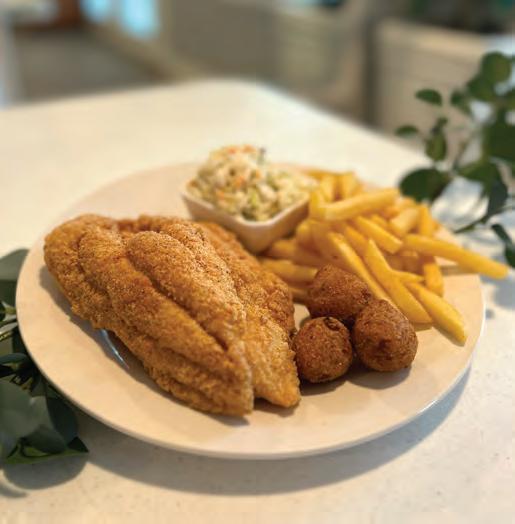
“As we do catering events, we get more referrals,” adds Joni. While Alabama Living was visiting, for example, the team was preparing for a large family reunion in Enterprise the next day. On the menu were roast beef, chicken, green beans, field peas, cornbread, rice, poundcake, tea and Bri’s Lemonade.
“Customers always comment on the great taste of Bri’s Fresh Squeezed Lemonade,” Joni says.
They also do pop-ups at special events out of town, bringing their customized mini-trailer loaded with sweets and other dishes in pre-packaged containers to sell at venues in other cities. “We’ve been all across the state, Dothan, Auburn, Birmingham,” she notes.
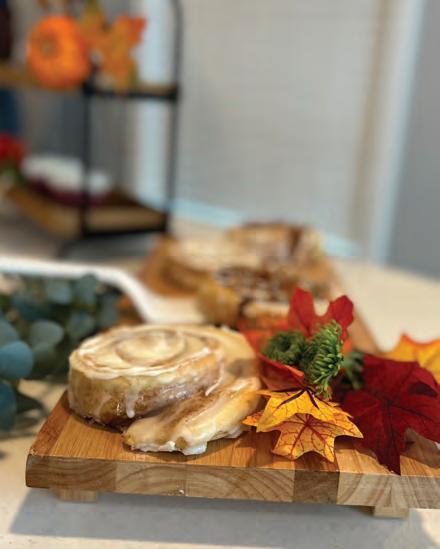
The Harrises rely heavily on their family team for support and input to make their business work. Their niece, Lilly C. Flowers, handles social media and marketing and her husband, Justin Flowers, is community service director and self-appointed “taste tester.” Their daughters Kayla and Brianna help with events and catering. Important decisions are made only after family discussions.

Both Joni, trained as an environmental engineer, and Quinton, an area manager with the USDA, continue to work their day jobs, while devoting their weekends to KayBri and Southern Venue. Sunday lunch has proven to be very popular, as customers flock in for a home-cooked meal after church. And Quinton looks forward to finishing up construction on their outdoor kitchen, which will allow him and his staff to have a larger place to fry catfish as well as cook larger quantities of food.
What accounts for their success so far? “I believe it’s because of customer service,” he says. “Our goal, our aim is to make every customer feel a warm welcome. We haven’t had any complaints. If we do, we want to do whatever we can do to be better.”
Kay-Bri Desserts/Southern Venue
8654 Freedom Farm Road
Furman, AL 36741


(334)557-0330
kaybridesserts@gmail.com
Follow them on Facebook or at kaybridesserts.com
Hours: Friday through Sunday only 10 a.m. to 6 p.m.
32 SEPTEMBER 2023 www.alabamaliving.coop
l
Furman
From left, family members Quinton, Kayla, Lilly Flowers, Joni, Kayla and Justin Flowers all work together to make Kay-Bri Desserts and Southern Venue successful.
PHOTO BY LENORE VICKREY
Joni’s famous cinnamon rolls are a popular menu item.
PHOTO BY KAYLA HARRIS
Quinton did the landscaping for Southern Venue’s home in Wilcox County.
PHOTO BY LENORE VICKREY
Catfish, fries, hushpuppies and coleslaw are often on the weekend menu.
PHOTO BY LENORE VICKREY

Putting your soils to the test
Here’s a little gardening quiz to kick off a new school year: What’s the most important test a gardener can take? A soil test, of course.
That’s because a soil test helps you understand the fertility status of the very earth that supports your favorite fruits, vegetables, lawns, trees, shrubs and flowers. A basic soil test will determine the level of essential nutrients (phosphorous, potassium, magnesium, and calcium) present in the soil and measure soil pH (which affects nutrient uptake in plants) and provide plant-specific nitrogen recommendations.
A soil test is easy to take, no studying or cramming required. It simply involves gathering a composite sample of soil from

across the planting area and sending it, along with a form detailing what crops you intend to grow, off to a professional laboratory for analysis. Within a week or so, results will arrive complete with specific recommendations on the amendments needed to make the soil its most productive. This information also helps avoid overapplication of fertilizers, which saves you money and helps protect the environment.
Here in Alabama, we are lucky to have an exemplary soil testing resource — the Auburn University Soil, Forage and Water Testing Laboratory. The lab was established in 1953 to provide economical fertilizer and lime recommendations to Alabama’s farmers and home gardeners, recommendations based on what is now 150 years of unbiased land-grant university research.
Since soil is a living system and always changing over time, this kind of historical data is invaluable to the lab and can also be a priceless tool for gardeners, which is why you need to frequently retest your soils. The standard recommendation is to repeat soil tests every three years, though Dr. Jessica Davis, manager of Auburn’s soil testing lab, said annual testing is an ideal way to stay on top of your soil’s progress, especially if the initial test called for significant corrections to soil pH or fertility or if your plants are exhibiting problems.
“We recommend doing the test (routine tests are $10 each) the same time each year,” she added, which is important because temperature and weather can seasonally impact pH levels.
Late winter and early spring prior to the start of a new growing season is the busi-

34 SEPTEMBER 2023 www.alabamaliving.coop
| Gardens |
Katie Jackson is a freelance writer and editor based in Opelika, Alabama. Contact her at katielamarjackson@gmail.com.
PHOTOS COURTESY AUBURN UNIVERSITY COLLEGE OF AGRICULTURE AND ALABAMA EXPERIMENT STATION
A single yard or garden can contain a variety of different soils each with its own nutrient profile, which is why it’s important to test soils before applying fertilizers, lime or other soil amendments. These tests are done at specialized testing facilities such as Auburn University’s Soil, Forage and Water Testing Laboratory where skilled technicians run a series of visual and chemical analyses that determine what essential ingredients are present or lacking in the soil. Using that information the can lab generate recommendations tailor made for each soil and crop.

est time at Davis’s lab but testing in the fall and early winter is just as effective. In fact, testing in the fall offers several advantages including beating the winter/spring rush and allowing plenty of time for fertilizers and lime to become incorporated into the soil before spring planting begins.
In addition to routine soil nutrient and pH testing, which Davis describes as “our bread and butter,” the lab can also test for soil particle size, micro-nutrient testing, determine the percentage of organic matter in the soil, and test for the presence of contaminants such as heavy metals. It also provides an array of testing options on feeds and forages, plant tissue, manure and poultry litter and water.
“Right now, we just test agricultural water, but hopefully by 2024 we will be EPA certified for drinking water analysis, especially for our customers on home well systems,” Davis says.
To learn more about all the services pro-


vided by the lab and to watch a video on how to properly take a soil test, visit aaes. auburn.edu/soil-forage-water-testinglab. Soil test kits are available throughout the state at county Extension offices or soil samples can be sent by the customer in a plastic bag with the form found on the website.
While Davis’s lab doesn’t test for soil diseases or pests, such as nematodes, it shares a building with another invaluable resource: Auburn’s Plant Diagnostic Lab. Learn more about their services and sampling procedures at aces.edu/blog/topics/farming/plant-diagnostic-lab-services

SEPTEMBER TIPS
Plant spring-blooming bulbs and annual flowers such as pansies, mums and zinnias.
Remove dead and diseased plant material from vegetable and flower garden beds.
Start planting shrubs and trees.
Plant cool-season vegetable crops such as leafy greens, broccoli, onions and carrots.
Divide and transplant overcrowded perennials such as hostas, daylilies, irises and ornamental grasses.
Continue to weed garden beds and landscape areas.
Take cuttings from woody shrubs and begin to root them.
Remove invasive plants from the landscape.
Start preparing areas to turn into wildflower and native grass meadows.
Clean and refill birdfeeders and baths.
36 SEPTEMBER 2023 www.alabamaliving.coop
Once they arrive at the lab, soil samples are dried and ground before undergoing several tests including mixing the soil in water to evaluate the soil’s level of acidity or alkalinity (soil pH), which will affect lime recommendations.
Scan this QR code to access the lab’s website.



Think before buying a purebred pet
It has been a while since we talked about pet overpopulation. Overpopulation simply means we are producing more pets than there are homes for. Approximately 3.7 million dogs enter shelters every year in the U.S.

That leads us to the question: Why are we producing more and more pets when we don’t have a home for all of them? Producers will produce as long as we buy… Basic supply and demand, right?
Why do we keep buying from producers? Vanity and dare I say, ignorance. By ignorance, I mean an inability and/or unwillingness to see the bigger picture. When we want something special and then procure it, we feel good about ourselves!

Many years ago, a family came in for their first puppy visit. They brought along a manilla folder about an inch thick. They proceeded to tell us about the ancestry of their new puppy in great detail. This was a golden doodle. I was a bit dumbfounded. After all, just 30 years ago, it would be considered a mixed breed dog, a “mutt!” Now, we carry around its “pedigree” like many of us carry our lineage chart that traces back to the Mayflower!
Now, don’t get me wrong, these people are fantastic human beings, and they love their fur babies to bits! But why do we buy a purebred dog? Maybe it’s a throwback to the old ways of thinking – that fleeting sense of pride in owning something extra special, more valuable, and pres tigious than just your everyday stray or mixed-breed mutt.
It is a complex sociological problem and not easy to define why we want a purebred pet, but movies and celebri ties are great motivators. Studies show that from 1927-2004, 87 movies have influenced dog breed choices, and these influences seem to last for about a de cade. Lassie had us all dreaming of collies and “101 Dalmatians” sparked the craze for the spotted dog! It’s like fashions and fads in the pet world. French bulldogs are the modern-day stars, but bless their hearts, they struggle to get enough oxygen, leading to all that adorable snorting and snuffling.
Now, let’s talk about the big I-word – Ignorance with a capital “I.” More than one client has told me that the shelter dogs are broken. I guess their logic is, why else were these dogs rejected from other homes? Many so-called purebred dogs were
developed by mixing other so-called “purebred” dogs. And going back in time, not a single dog ever landed on this planet as a purebred dog. In the past, we talked about the origin and evolution of dogs. Many of the modern “purebred” dogs are in fact mixed breed dogs selected for different character or physical traits, and selectively bred generation after generation.
The value of the dog or a cat is not in the title (Labrador, Shepherd, golden, Maine coon, Bengal, etc.), but in how they teach us how to give unconditional love. The love we find a little challenging to give to another human for the fear of rejection or expecting reciprocation, we can give freely to animals. Our love is in the personality of the pet, and our connection to them, not their appearance!
Over the years, we have collaborated with many rescue groups. They pick up the pieces where society has tossed out unwanted, excess animals. Rescuers are the golden children of the pet world. However, the sad reality is that all of them, including very large rescue organizations, are always feeling overwhelmed, always trying to make ends meet, and always failing to find homes for the number of pets that
Maybe, just maybe, before you look at FB for dogs for sale, browse the Petfinder website. What we really want is a pet’s personality that fits us, not a specific breed. But if you have a purebred dog, there are many organizations that do rescues of specific breeds. If you visit the American Kennel Club rescue network website at akc. org/akc-rescue-network , there are lists of purebred rescue organizations for almost any breed you can
Overall, there is some good news. Over the last decade, euthanasia in shelters has steadily been decreasing. And one study from Hungary cited that about 45-55% of the dogs in U.S. households are mixed breed. Things are changing for the better!
40 SEPTEMBER 2023 www.alabamaliving.coop PET HEALTH
Goutam Mukherjee, DVM, MS, Ph.D. (Dr. G) has been a veterinarian for more than 30 years. He owns High Falls Holistic Veterinary Care near Geraldine, Alabama. To suggest topics for future discussions, email him at contact@ alabamaliving.coop

Alabama Living SEPTEMBER 2023 41
Hunters need to open their bag of tricks to fool doves

Many people only hunt doves for a weekend or two, perhaps only one day, in September to kick off another hunting season, but the birds can provide exciting action into January.
The 2023-24 Alabama dove season opens in the North Zone at noon Sept. 2. The first split runs through Oct. 22. In the South Zone, the first split runs from noon Sept. 9 through Oct. 29.
The seasons reopen statewide from Nov. 18-26 and again from Dec. 16 until sunset on Jan. 14, 2024. Sportsmen can bag up to 15 doves per day in any combination of mourning and whitewinged doves.
As a bonus, Alabama sportsmen may also shoot Eurasian collared doves, an exotic species native to south Asia, without limit or season. During dove season, collared doves do not count in the daily dove bag limit. Much bigger than mourning doves, collared doves grow nearly as large as park pigeons. The distinctive grayish-black collars around their necks and squared tails provide the best identifying features.
To hunt doves, sportsmen must first find them. Hundreds of birds might crowd a field one day, but disappear the next, particularly as hunting pressure increases. To find doves, look for the four main things they require: food, cover, water and grit.
“A dove’s diet consists of about 99 percent seeds,” says Seth Maddox, the Alabama Division of Wildlife and Freshwater Fisheries Migratory Game Bird Coordinator. “They eat any type of cultivated grain such as corn, millet, sorghum, also called milo, and even peanuts. They also eat native grass seeds, herbs and weed seeds. Occasionally, they’ll eat berries or maybe even something like snails for calcium.”
The small birds like to feed in fields with bare, open dirt at ground level under a protective leafy canopy that can hide them from hawks and other predators. Sunflower fields provide doves outstanding feeding conditions and cover. Many landowners plant sunflowers specifically for doves.
When feeding, doves usually cluster in a circle so they can watch for danger coming from all directions. Some sportsmen use spinning wing decoys on a pole that create flash like a bird landing. Place static dove decoys around the pole in about a

10-yard radius circle to simulate feeding birds. Attach a few more static decoys to low bushes, fence wires or other places to mimic lookouts.
Doves ordinarily feed at first light. After filling their bellies, they look for “nooning” places where they can rest and digest. While “nooning,” they perch in tall trees, on electrical wires or other places that give them good vantage points to watch for danger. They might stay in their perches most of the day unless disturbed. By late afternoon, birds want to feed again.
Toothless birds need to ingest small pieces of gravel or sand to help break up the hard seeds they swallow whole. Doves frequently go to grit piles or sandy patches to swallow grit, making these piles great places to hunt in mid-morning or afternoon.
Doves also need water to aid digestion. Right before sundown, doves look for a place to drink. In late afternoon, the birds commonly congregate around streams or ponds with sandy or gravel shorelines. A small bird like a dove does not need to visit a huge lake to drink. Just a tire rut filled with water on a gravel or dirt road could provide them with grit and liquid.
Ever mindful of predators, doves typically don’t go directly down to drink. They normally first land in a high vantage place to watch for predators before dropping to the ground. Therefore, when hunting near a water source, place a few decoys on tree limbs like lookouts. Then, add a couple more decoys in an open, gritty area near water to simulate dusting or drinking birds.
Hunters looking for more active, adrenaline-pumping excitement might try jumping doves. Almost like quail hunting, but without dogs pointing coveys for them, hunters walk along tree lines, fencerows, through low brushy savannas or high grasslands to flush birds from cover. Their broad, elliptical wings make a distinctive fluttering clatter, instantly alerting hunters to their presence.
Many sportsmen hunt private lands, but some public properties offer excellent dove action. Some better dove wildlife management areas include Barbour, Blue Springs, Geneva State Forest, Lowndes and Perdido River.
Many of the Special Opportunity Areas offer dove hunting opportunities. For a list of properties, regulations, seasons and other information, see outdooralabama.com/hunting/specialopportunity-areas
For zone boundaries and other information, see outdooralabama.com/seasons-and-bag-limits/mourningand-white-winged-dove-season
42 SEPTEMBER 2023 www.alabamaliving.coop | Outdoors |
A Mojo spinning wing decoy helps bring in the mourning doves. The spinning wings give off flash that simulates flapping wings. Birds can see them from a long way off.
PHOTO BY JOHN N. FELSHER
John N. Felsher is a professional freelance writer who lives in Semmes, Ala. He also hosts an outdoors tips show for WAVH FM Talk 106.5 radio station in Mobile, Ala. Contact him at j. felsher@hotmail.com or through Facebook.
CECIL PIGG CECIL PIGG STEEL TRUSS, INC.

P.O. BOX 389, ADDISON, AL 35540
WE SELL: Steel Trusses • Hay Barns Lumber • Equipment Sheds Building Material Packages Painted Metal • Work Shops Insulation • Kneebraces

Galvalume Metal
STEEL TRUSS BUILDINGS BUILT TO YOUR SPECIFICATIONS

256-747-8178 • FAX: 256-747-8760

DOUG HANNON’S FISH & GAME FORECAST

The Moon Clock and resulting Moon Times were developed 40 years ago by Doug Hannon, one of America’s most trusted wildlife experts and a tireless inventor. The Moon Clock is produced by DataSport, Inc. of Atlanta, GA, a company specializing in wildlife activity time prediction. To order the 2023 Moon Clock, go to www.moontimes.com.

Alabama Living SEPTEMBER 2023 43
2023 EXCELLENT TIMES MOON STAGE GOOD TIMES SEPTEMBER A.M. PM AM PM Su 1 7 2:06 - 4:06 2:30 - 4:30 8:33 - 10:03 8:57 - 10:27 Mo 18 2:54 - 4:54 3:18 - 5:18 9:21 - 10:51 9:45 - 11:15 Tu 19 3:42 - 5:42 4:06 - 6:06 10:09 - 11:39 10:33 - 12:03 We 20 4:30 - 6:30 4:54 - 6:54 10:57 - 12:27 11:21 - 12:51 Th 21 5:18 - 7:18 5:42 - 7:42 NA 12:09 - 1:39 Fr 22 6:06 - 8:06 6:30 - 8:30 12:33 - 2:03 12:57 - 2:27 Sa 23 6:54 - 8:54 7:18 - 9:18 1:21 - 2:51 1:45 - 3:15 Su 24 7:42 - 9:42 8:06 - 10:06 2:09 - 3:39 2:33 - 4:03 Mo 25 8:30 - 10:30 8:54 - 10:54 2:57 - 4:27 3:21 - 4:51 Tu 26 9:18 - 11:18 9:42 - 11:42 3:45 - 5:15 4:09 - 5:39 We 2 7 10:06 - 12:06 10:30 - 12:30 4:33 - 6:03 4:57 - 6:27 Th 28 10:54 - 12:54 11:18 - 1:18 5:21 - 6:51 5:45 - 7:15 Fr 29 NA 12:06 - 2:06 FULL MOON 6:09 - 7:39 6:33 - 8:03 Sa 30 12:30 - 2:30 4:54 - 6:54 10:57 - 12:27 11:21 - 12:51 OCTOBER A.M. PM AM PM Su 1 1:18 - 3:18 1:42 - 3:42 7:45 - 9:15 8:09 - 9:39 Mo 2 2:06 - 4:06 2:30 - 4:30 8:33 - 10:03 8:57 - 10:27 Tu 3 2:54 - 4:54 3:18 - 5:18 9:21 - 10:51 9:45 - 11:15 We 4 3:42 - 5:42 4:06 - 6:06 10:09 - 11:39 10:33 - 12:03 Th 5 4:30 - 6:30 4:54 - 6:54 10:57 - 12:27 11:21 - 12:51 Fr 6 5:18 - 7:18 5:42 - 7:42 NA 12:09 - 1:39 Sa 7 6:06 - 8:06 6:30 - 8:30 12:33 - 2:03 12:57 - 2:27 Su 8 6:54 - 8:54 7:18 - 9:18 1:21 - 2:51 1:45 - 3:15 Mo 9 7:42 - 9:42 8:06 - 10:06 2:09 - 3:39 2:33 - 4:03 Tu 10 8:30 - 10:30 8:54 - 10:54 2:57 - 4:27 3:21 - 4:51 We 11 9:18 - 11:18 9:42 - 11:42 3:45 - 5:15 4:09 - 5:39 Th 12 10:06 - 12:06 10:30 - 12:30 4:33 - 6:03 4:57 - 6:27 Fr 13 10:54 - 12:54 11:18 - 1:18 5:21 - 6:51 5:45 - 7:15 Sa 14 NA 12:06 - 2:06 NEW MOON 6:09 - 7:39 6:33 - 8:03 Su 15 12:30 - 2:30 12:54 - 2:54 6:57 - 8:27 7:21 - 8:51 Mo 16 1:18 - 3:18 1:42 - 3:42 7:45 - 9:15 8:09 - 9:39 Tu 1 7 2:06 - 4:06 2:30 - 4:30 8:33 - 10:03 8:57 - 10:27 We 18 2:54 - 4:54 3:18 - 5:18 9:21 - 10:51 9:45 - 11:15 Th 19 3:42 - 5:42 4:06 - 6:06 10:09 - 11:39 10:33 - 12:03 Fr 20 4:30 - 6:30 4:54 - 6:54 10:57 - 12:27 11:21 - 12:51 Sa 21 5:18 - 7:18 5:42 - 7:42 NA 12:09 - 1:39 Su 22 6:06 - 8:06 6:30 - 8:30 12:33 - 2:03 12:57 - 2:27 Mo 23 6:54 - 8:54 7:18 - 9:18 1:21 - 2:51 1:45 - 3:15 Tu 24 7:42 - 9:42 8:06 - 10:06 2:09 - 3:39 2:33 - 4:03 We 25 8:30 - 10:30 8:54 - 10:54 2:57 - 4:27 3:21 - 4:51 Th 26 9:18 - 11:18 9:42 - 11:42 3:45 - 5:15 4:09 - 5:39 Fr 2 7 10:06 - 12:06 10:30 - 12:30 4:33 - 6:03 4:57 - 6:27 Sa 28 NA 12:06 - 2:06 FULL MOON 6:09 - 7:39 6:33 - 8:03 Su 29 12:30 - 2:30 12:54 - 2:54 6:57 - 8:27 7:21 - 8:51 Mo 30 1:18 - 3:18 1:42 - 3:42 7:45 - 9:15 8:09 - 9:39 Tu 31 2:06 - 4:06 2:30 - 4:30 8:33 - 10:03 8:57 - 10:27
Cook of the Month: John Sunyog, Cullman EC

As a child growing up in the Detroit, Michigan, area, John Sunyog was used to having easy access to a variety of foods from different cultural backgrounds. “Up there you had Greek, Mediterranean, Middle Eastern, Polish, Jewish,” he says. So if his mother wasn’t in a baking mood he could find his favorite krusciki, or Polish twists, at a local bakery. “As a kid I loved eating those things.” But another kind of love brought him south to Alabama when he moved with his fiancé to the Cullman area in 2005. Not finding the variety of food cultures he was used to, he had to go back to his mother’s recipe for the light, flaky pastries sprinkled with powdered sugar that he loved to eat. “The recipe is over 100 years old and has been passed down in my family for generations,” he says. He likes to make the treats for a special occasion “because it takes a little bit of time to make the dough and to get everything up and going. But the outcome is definitely worth it!” (He recommends not storing them in an airtight container, but in a bowl covered lightly with a towel to keep dust off.)

2/3 cup egg yolks (approximately 8)
1 cup sour cream
1 tablespoon sugar
1 teaspoon vanilla extract (real is better than imitation)
1/4 teaspoon salt
3 cups sifted flour

Powered sugar, for topping
Combine egg yolks, sour cream, sugar, vanilla and salt. Add flour and make a stiff dough. Place on a floured board and knead until smooth, but not sticky. Divide the dough in half and cover one part. Roll the other part very thin on a floured board. Cut into strips about 1½-inches wide, then cut each strip into diamond-shaped pieces about 4-inches long. Make a diagonal slit about 1-inch long in the center of each diamond, then pull one end through the opening. Fry in deep fat at 385 degrees for about 1 minute or until brown. Drain on absorbent paper, then sprinkle with powdered sugar. Store in an open basket to keep crisp. The other half of the dough that is set aside in the recipe can be used later or make a second batch right away.
| Alabama Recipes |
Food styling and photos: Brooke Echols
Krusciki (Polish Twists or Angel Wings)
44 SEPTEMBER 2023 www.alabamaliving.coop
Polish Twists (or Angel Wings)
Sweet and Sour Pork
1 pound pork tenderloin (cut into 1-inch cubes)
Marinade:
1 tablespoon red wine
2 tablespoons soy sauce
1 teaspoon ginger, minced
½ teaspoon accent

Place cubed pork tenderloin in a bowl. Pour marinade over the pork, stir, cover with a lid. Let meat soak in the marinade for a minimum of 3 hours or overnight in the refrigerator.
Batter:
2 egg yolks or 1 egg
4 tablespoons cornstarch
Mix batter well. Add additional cornstarch, if necessary, to achieve a stiff batter. Drain marinade from the meat and combine the meat with the batter. Deep fry at 420 degrees until crisp and golden brown. Turn out onto a platter lined with paper towels.
Sauce:
6 tablespoons sugar
½ cup pineapple juice
2 tablespoons soy sauce

½ cup water
1 tablespoon red wine
3 tablespoons ketchup
3 tablespoons vinegar
2 tablespoons cornstarch
Combine sugar, soy sauce, wine, vinegar, pineapple juice and ketchup in a medium boiler and bring to a boil. Mix the cornstarch with water. Add to boiling ingredients and stir until thickened.
Vegetables:
1 green and red bell peppers, cut in 1-inch squares
1 cup carrots, thinly sliced on the diagonal
1 onion, cut in 1-inch squares
1 can bamboo shoots, sliced
1 can water chestnuts, sliced
1 can pineapple chunks
Fry vegetables in a Wok using 6 tablespoons of canola oil heated to 420 degrees for a few minutes or just until vegetables take on a transparent appearance. Add the pork tenderloin to the wok. Pour the sweet and sour sauce over the meat and vegetables. Blend well and serve over steamed long grain white or Jasmine Rice.
Janet Parker Central Alabama EC
Every recipe has a story. Whether they’re new or old, we all connect somehow to certain dishes. They can be handed down for generations or be new heritage recipes we create through our own lives. This month’s topic of international recipes allowed me to go back to my Scottish roots. Traditional Scottish Oatmeal Rolls are a dream dinner roll. They are easy with only a 1.5 hour rise time. The taste and texture is everything you want in a yeast roll. Made with all-purpose flour, brown sugar and old fashioned oats, this centuries-old recipe is the perfect dinner roll! For this recipe and more, visit our website at thebutteredhome.com.
Traditional Scottish Oatmeal Rolls
1½ cups old-fashioned oats
1/3 cup brown sugar
½ cup boiling water
½ teaspoon salt
1/4 ounce dry active yeast

1/4 cup warm water, 110 to 115 degrees
3½ cups all-purpose flour
1 tablespoon oil
Place oatmeal in a large bowl. Pour boiling water over oats and mix well. Add brown sugar, salt and oil and mix well.
In a small bowl, dissolve active dry yeast with 1/4 cup warm water. Test temperature of water to make sure it's no lower than 110 degree F and no higher than 115 degrees F. This ensures yeast will activate as well as remain alive. Allow to stand for 5 minutes or until it blooms and is foamy. Add yeast and water to oat mixture and mix well. Add flour in stages until a sticky but stiff dough forms. Turn dough onto a lightly floured surface and shape and knead. Knead for 6-8 minutes until dough is smooth.
Shape dough into a ball and place in a lightly greased bowl, turning to oil all sides of dough. Cover and allow to rise until it doubles in size, about an hour. Punch down dough and separate into 24 balls. Roll balls until smooth and place in a lightly greased baking pan. Cover and allow to rise again for 30 minutes.
Preheat oven to 350 degrees. Bake rolls for 20-25 minutes until browned. You can drizzle with salted butter and bake a few minutes more to obtain extra browning. Serve warm.
 Brooke Burks
Photo by The Buttered Home
Brooke Burks
Photo by The Buttered Home
Alabama Living SEPTEMBER 2023 45
Weiner Schnitzel with Brown Gravy
Weiner Schnitzel:
4 5- ounce veal cutlets
½ cup breadcrumbs
1/4 cup all-purpose flour
2 eggs beaten
4 slices of lemon, garnish
½ teaspoon salt
Canola oil, for shallow frying
Brown Gravy:
1½ cups beef broth
2 tablespoons all-purpose flour
½ stick butter
2 tablespoons heavy cream
Salt and pepper, to taste
Place veal cutlets on cutting board. Cover with a piece of plastic wrap. with a heavy mallet, pound out meat evenly flat to 1/4-inch thickness. Bread the veal with flour and salt first; then dredge in beaten eggs; lastly the breadcrumbs. In a large skillet heat canola oil to 350 degrees. Fry 2-3 minutes per side until golden brown. Drain excess oil on wire rack.
Brown Gravy: Pour broth in same skillet used to cook veal and scrape loose the brown bits from the bottom of the pan. When it starts to boil, slowly stir in flour. Stir constantly until mixed well. Add butter and heavy cream. Continue stirring until desired consistency is reached. Add salt and pepper. Serve gravy over Weiner Schnitzel with your favorite side. Garnish with lemon slices.
Kirk Vantrease
Cullman EC
Sukuma Wiki (Kenyan-Style Collard Greens)
1 bunch of collards (may substitute or combine kale or other greens)
1 large sweet onion, chopped
2-3 ripe tomatoes, diced (or 1 15-ounce can diced tomatoes)
2-3 cloves fresh garlic, chopped or crushed
1 hot green pepper, de-seeded and diced finely (or ½ teaspoon crushed red pepper flakes)
1/4 teaspoon smoked paprika
1/4 teaspoon salt
1/4 cup canola or vegetable oil
Wash greens thoroughly several times. Cut the collard greens in half lengthwise and remove stems. Stack greens and slice crosswise into strips about ½-1inch width. Set aside.
In a large skillet over medium high heat, cook chopped onion, garlic and green pepper in the oil for about 1-2 minutes until softening, stirring to prevent burning. Stir in paprika and salt, then add diced tomatoes and continue stirring and cooking for another 3 or 4 minutes. If using canned or frozen tomatoes, drain before adding, but save juices to add later if needed. Add the greens and continue stirring until bright green and beginning to wilt. Lower temperature, cover and cook for 5 to 10 minutes until the greens are as tender as you like. During this time, stir occasionally and add a tablespoon or two of tomato juice or water if needed to prevent sticking and burning. The greens should not be watery. Taste and adjust seasonings as desired.
If desired, after tomatoes you may add chopped, leftover, cooked meat—beef, pork, goat, chicken—or tofu. Traditionally Sukuma Wiki is served with Ugali, a mush of coarsely ground cornmeal, similar to polenta or stiffly cooked stoneground white grits but goes well also with Southern cornbread.
Ruth Coulter Bentley
Sand Mountain EC
Chicken Curry
1 whole chicken, cut up and breasts cut in half mak ing small pieces of meat
½ cup butter
1 can chicken broth
Brown chicken in hot butter, 5 minutes per side. Add the broth and bring to a boil. Reduce heat, cover and simmer for 10 minutes. Remove the chicken and keep warm. Measure liquid in skillet and add water to make 3 cups of broth.
Sauce:
3 tablespoons butter
1 clove garlic, crushed
1 cup onion, chopped
3 teaspoons curry powder, bought or homemade
1/4 cup flour
1/4 teaspoon cardamom
2 teaspoons fresh ginger, grated
1 teaspoon salt
1/4 teaspoon pepper
2 teaspoons lime peel
2 tablespoons lime juice
Extra:
3 white potatoes, peeled and cubed
2 sticks cinnamon
5 whole cloves
1 green chili pepper
In the skillet, melt butter and sauté garlic, onion, ginger and curry powder. This brings out the flavor of the spices. Remove from the heat and stir in flour, cardamom, salt and pepper. Gradually stir in chicken, reserved broth, lime peel and lime juice. Bring to a boil. Pour into large dutch oven and add potatoes, cinnamon, cloves and place chili pepper on top. Cover and cook on 350 for about 90 minutes. Serve with hot basmati rice, naan and a squeeze of lime on top.
Judy Colley Tallapoosa River EC
WIN $50!
January:
Chicken wings, ribs & things

Enter by: October 6
More themes and deadlines:
February:
Better with butter | Nov. 3
Visit our website: alabamaliving.coop
Email us: recipes@alabamaliving.coop
USPS mail:
Attn: Recipes, P.O. Box 244014 Montgomery, AL 36124
Cook of the Month wins $50! Recipes can be developed by you or family members. You may even adapt a recipe from another source by changing as little as the amount of one ingredient. Chosen cooks may win “Cook of the Month” only once per calendar year. To be eligible, submissions must include a name, phone number, mailing address and co-op name. Alabama Living reserves the right to reprint recipes in our other publications.
46 SEPTEMBER 2023 www.alabamaliving.coop

Alabama Living SEPTEMBER 2023 47
Making your windows energy efficient

Q:My windows are old and drafty, and I’m thinking about replacing them. Can you recommend a few options I should consider?
A:Upgrading or improving your windows is an important component of your home’s energy efficiency. According to the Department of Energy, heat gain and loss through windows consumes 25% to 30% of residential heating and cooling energy use.
Start by identifying the kind of windows you have. Are they single pane or double pane? Looking closely at the window’s edge, you can see the number of windowpanes. Are the frames metal, wood or vinyl? Some manufacturers etch the make and model numbers in a corner of the glass, so you can look up the manufacturer for more information.
Single-pane windows and double-pane windows with metal frames are the least energy efficient. The lower the efficiency of your existing windows, the higher the potential for energy savings.
There are several options for improving your windows, ranging from replacement windows to storm windows to budget-friendly repairs.
Window efficiency
Several components can make windows more efficient. High-quality frame materials insulate and reduce heat transfer. Two or more panes of glass with space in between (filled with air or gas) improve the window’s insulation capability. Warm edge spacers hold the panes of glass the proper distance apart and help insulate the edges of the panes. Low-emissivity coatings applied to the glass can reflect infrared light, keeping the heat in during the winter and out during the summer.
Window efficiency is rated in U-factor and Solar Heat Gain Coefficient, or SHGC. U-factor measures heat transfer through

the window, which relates to how well it insulates. The lower the U-factor, the more efficient the window. The SHGC measures how effectively the window blocks heat from the sun.
Replacement and maintenance
If you want to replace your existing windows, I recommend shopping for ENERGY STAR®-certified windows. ENERGY STAR® sets specific U-factor and SHGC requirements based on your geography, so you get the best fit for your location. Replacement windows offer additional benefits, like improved operability and aesthetics. As with many industries, the window industry has been impacted by price increases over the past few years, so keep in mind, this can be an expensive upgrade.
Storm windows are a lower-cost solution for some homes. Traditional storm windows are made with clear glass. Low emissivity storm windows have energy savings similar to replacement windows at about a third of the cost.
Storm windows are mounted to the interior or exterior and are available in operable styles, so you can still open and close your windows. Look for ENERGY STAR®-certified models.
If you want to maintain the historic architecture of your existing windows, low-e storm windows are a great option. Some companies can refit your existing window frames with custom double-pane glass and weatherstripping.
As with any home improvement project, be sure to get multiple quotes to compare pricing and scope of work. You may find additional savings with rebates from your electric co-op, or state or federal tax credits for window upgrades.
If new windows or storm windows are not in the budget, your best bet is to maintain your existing windows. Keep the paint and caulking on the exterior in good condition. That will help prevent damage from the elements. Caulk around the inside trim, ensure sash locks are installed properly and seal tight when locked. There are a variety of weatherstripping types for windows to keep drafts at bay.
Whether you replace or make improvements to what you have, adding efficiency to your windows will add year-round comfort to your home.
48 SEPTEMBER 2023 www.alabamaliving.coop | Consumer Wise |
Miranda Boutelle is the chief operating officer at Efficiency Services Group in Oregon, a cooperatively owned energy efficiency company. She has more than 20 years of experience helping people save energy at home, and she writes on energy efficiency topics for the National Rural Electric Cooperative Association, the national trade association representing more than 900 local electric cooperatives.
Two or more panes of glass improve the insulation capability of the window.
PHOTO COURTESY ALPEN HIGH PERFORMANCE PRODUCTS





Alabama Living SEPTEMBER 2023 49 Put your brand in front of more than a MILLION readers EVERY MONTH! Advertisers trust Alabama’s largest consumer publication, making it a powerful & efficient media buy. Call (800) 410-2737, or Email: advertising@areapower.com ADVERTISE HERE Answers to puzzle on Page 28
We’re Proud to Power
FRIDAY NIGHT LIGHTS
To all the players, coaches and supporting sta , we wish you a great and safe 2023 football season. We’re rooting for you.


50 SEPTEMBER 2023 www.alabamaliving.coop
On the last Saturday in October, this annual harvest and heritage celebration pays tribute to the foodstuff that sustained our community through the Great Depression. The little nut continues to boost the local economy as visitors travel from all over to join in the fun.
• Old-time demonstrations
• Peanut butter recipe contest



• Arts and crafts
• Games and contests


• Festival foods and more
arts and crafts or food vendor, contact Cathy Steed at 334-685-5524.

is back!
The
an
For information on becoming
ADOBE STOCK IMAGES BY JJAVA
Brundidge is
to announce the
is back for 2023. Join us on the grounds of the historic Bass House. Free admission Opens at 8 a.m. Oct. 28 Saturday, 5K Peanut Butter Run — 8 a.m. Nutter Butter Parade — 1 p.m. (Registration available on race day starting at 7 a.m.)
The town of
excited
Peanut Butter Festival
Early morning thoughts
It’s early Sunday morning, the first weekend in August, and I’m thinking about current events. My screened-in porch is hot, even early in the morning. My daughter, Kalli, and her two youngest daughters are relocating back from Atlanta and spending the weekend with us. I was exiled to the back porch last night to watch anything other than the Paw Patrol pack of pups saving bunnies and the farmland. It was hot on the back porch last night, too.
The papers and internet are full of articles about July being the hottest month in recorded history. It has been hot, but I’m not too sure of, nor overly impressed by, the hottest month in history claim. First, the recorded global average temperature for the first 23 days of July 2023 was 62.5 degrees Fahrenheit, according to the Associated Press. It has been hot, but the average temperature is still just an average, not an absolute. Second, the southern half of the earth is in the middle of winter and probably welcoming warmer temperatures. Third, 62.5 F isn’t debilitating – a high of nearly 120 F in Arizona might be (or maybe they are used to it), but high temperatures like the ones in Arizona certainly slant the averages.
The Kansas City Star states that July 2023 was not nearly the hottest month in Kansas City’s history. The 77 F average temperature, although hotter than the world average, was only the 99th hottest and the 35th coolest on record in Kansas City (Averages are funny facts). I still recall the summer of 1980 in Birmingham. My wife was pregnant with our oldest daughter, and the temperature was over 100 F for 20 straight days. I have no idea what the average was - that may have been before recorded history - but it was hot in 1980, too.
Then we have David Gelles and Manuela Andreoni, two correspondents for The New York Times Climate Forward, neither of whom apparently claim any climate expertise other than Ms. Andreoni serving as a fellow at the Rainforest Investigation Network, who recently wrote, “But, there are two things we can say with certainty: Oceans are the hottest they have ever been in recorded history, by a wide margin, and man-made climate change is to blame.” They are certain; El Nino is a little surprised.
Aside from climate, former President Trump has also been a

constant topic for news stories. Back in May, I wrote about Trump facing felony charges for falsifying business records, related to reportedly paying off an adult film star to suppress a story that she allegedly was paid hush money to cover up an extramarital affair between the two. In that article I remarked about how political morals had changed over the decades to the degree that such allegations did not harm his political standing. Of course, Trump has collected numerous other indictments since then, and his political standing continues to increase. A few more indictments – they don’t seem to be slowing down – and he will be declared President by acclamation.

And today, a Russian Court sentenced opposition leader Alexei Navalny to 19 years in prison for “Supporting Extremism.” Mr. Navalny was already serving a nine-year prison sentence. We are lucky that Supporting Extremism is not a crime in the U.S. Otherwise, our jails would be full of a few ex-Presidents, a current President, and extremists from both parties.
I also wrote in May about some people suffering anxiety because of all the music choices on paid music sites, trouble setting up personalized playlists, and how the shuffle button has caused disorder in the world. Last week, I drove to Birmingham. I put the top down and played Robert Earl Keen Radio and Micky and the Motorcars Radio with the shuffle button on. All enjoyment, no anxiety at all.
So, other than I didn’t have anything worthwhile to write about this month – and I am not sure this passes the test – what is all this about? These are my observations about the stories in the news, electronic newspapers on the internet, and how biased or silly some articles are. I could state here that The New York Times Climate Forward lists more than 100 articles about how climate change is destroying the world and why extreme urgent action is needed. My critics claim I am fixated on climate change – they haven’t read Climate Forward.
Instead, I will say there is a lot written and said that has little relation to facts. There are no free lunches. Be careful what you support or believe.
I hope you have a good month.
52 SEPTEMBER 2023 www.alabamaliving.coop | Our Sources Say |
Gary Smith is President and CEO of PowerSouth Energy Cooperative.
How To Place a Line Ad in Marketplace
Closing Deadlines (in our office):
November 2023 Issue by September 25
December 2022 Issue by October 25
January 2024 Issue by November 22
Ads are $1.75 per word with a 10 word minimum and are on a prepaid basis; Telephone numbers, email addresses and websites are considered 1 word each. Ads will not be taken over the phone. You may email your ad to hdutton@areapower.com; or call (800)410-2737 ask for Heather for pricing.; We accept checks, money orders and all major credit cards. Mail ad submission along with a check or money order made payable to ALABAMA LIVING, P.O. Box 244014, Montgomery, AL 36124 – Attn: Classifieds.
Miscellaneous
TIMESHARE VICTIMS! - Call (800)223-1770TimeShareBeGone.com - Timeshares legally cancelled for less - A+BBB Rating - Five Star Reviews - 100% Money Back Guarantee! Trust is our reputation! Since 2007
ADAM’S LAWN SERVICE – Mowing, Trimming, Weeding, Hedge Trimming, Fertilizer, Weed Control, Mulching, Brush Removal, Bobcat work and much more – (256)962-2393
FREE MATERIALS: SOON CHURCH / GOVERNMENT UNITING, suppressing “RELIGIOUS LIBERTY”, enforcing NATIONAL SUNDAY LAW, Be informed! Need mailing address only. POB 374, Ellijay, GA 30540 –tbsmads@yahoo.com, (888)211-1715

WALL BEDS OF ALABAMA - SOLID WOOD & LOG FURNITURE – Outdoor Rockers, Gliders & Swings, HANDCRAFTED AMISH CASKETS $1,599 - ALABAMA MATTRESS OUTLET – SHOWROOM Collinsville, AL – Custom Built / Factory Direct(256)490-4025, www.wallbedsofalabama.com, www.alabamamattressoutlet.com
TRI-STATE FENCE – Cullman, AL (256)5856630. IN BUSINESS SINCE 1972. We furnish & Install commercial, industrial and residential security fences specializing in institutional & high security. Covering Alabama, Mississippi, Georgia, Tenn. & Louisiana.
Vacation Rentals
GULF SHORES / ORANGE BEACH / FORT MORGAN – Choose from hundreds of beach houses and condos! Verified Owners. No Booking Fees. ALAVHR.com
GATLINBURG – DOWNTOWN LUXURY CREEKSIDE CONDO – 2BR / 2BA, sleeps 6 –aubie552@gmail.com, (256)599-5552
AFFORDABLE BEACHSIDE VACATION CONDOS – SUGAR BEACH CONDOS in ORANGE BEACH, AL – Rent Direct from Christian Family Owners – Lowest Prices on the Beach! www. gulfshorescondos.com, (251)752-2366, (251)656-4935
MENTONE, AL LOOKOUT MOUNTAIN COTTAGE RENTALS – Best brow views, River Front –cottagesofmentone.com, Call or text (504)4818666
PANAMA CITY BEACH CONDO – Owner rental – 2BR / 2BA, wireless internet, just remodeled inside and outside – (502)7777819, larrysusmichel@reagan.com, www. theroneycondo.com
Pet Friendly – Save $$$ by booking directly from Verified Owners. ALAVHR.com
MILITARY / SERVICE DISCOUNTS on dozens of rentals. No Booking Fees. (251)333-6500, ALAVHR.com


GULF SHORES BEACH FRONT CONDOS – 1BR / 2BA and 2BR / 2BA, Great beach views, open dates for late Summer and Fall – (256)3525721, amariewisener@gmail.com.
OWNERS – Join the fastest growing regional site in Alabama. Low annual fee. Verified Owners, no booking fees or commissions. Alabama Vacation Home Rentals. Locally Owned and Operated. (251)333-6500, ALAVHR.com





Farm / Agriculture
GROW MUSCADINES AND BLACKBERRIES , half dollar size – We offer over 200 varieties of Fruit and Nut Trees plus Vines and Berry Plants . Free color catalog. 1-800-733-0324. Ison’s Nursery, P.O. Box 190, Brooks, GA 30205 Since 1934 www.isons.com
Alabama Living SEPTEMBER 2023 53
us out on Facebook.
7315 County Road 17 • Woodville, AL 35776 256-805-0153 • macy@libertymonument.net Serving North AL, Southern TN, and Northwest GA. We offer traditional sandblast and laser etched monuments. Onsite cemetery engraving. Check
A serendipitous introduction
It all began with stand-up comedy. Once, when I was in LA (that’s Los Angeles, not Lower Alabama) for a meeting, I went to my first comedy club. For whatever reason, it filled me with the urge to get up and tell jokes. So I did. I thought one time on stage would scratch my itch. Wrong. I did well enough that I decided to enter an amateur comedy contest in Birmingham - which I won. I was fully infected now and became a full-time, part-time comic. Soon, a local morning radio team who had seen me perform asked me to write a few jokes for their show. To give you an idea how long ago it was, they paid me in cassette tapes.
I began watching Jay Leno perform his monologue on “The Tonight Show.” An idea germinated. What if I sent Leno some of my jokes and asked him to critique them?
So I got out a legal pad and wrote a letter to Jay, one comedian to another. I enclosed about four pages of my comedic gems along with a self-addressed stamped envelope.
Two weeks later, I was working in my downtown office when my wife called. Foregoing any pleasantries, she said, “ Hey. Have you sent some kind of letter to Jay Leno?”
My heart jumped. “Why are you asking me that?”
“Because I think I might’ve just made a fool out of myself.”
I wisely did not respond to that statement. Instead, I asked
innocently, “What could you possibly mean?”
“Well, I just got a phone call from somebody saying they were Jay Leno. He said he wants you to sign a writing contract. It was a pretty lame impersonation, so I’m assuming it’s one of your idiot friends playing a joke on you.”

It turns out it really was Jay. He had looked over my jokes and liked the stuff I submitted! Almost immediately, I was spending my evenings culling news, writing gags, and faxing them to Mr. Leno.
I continued performing, and word spread of my connection with the King of Late Night. Soon, others were interested in me performing for corporate gigs and writing for people who needed humor. Once Paul Finebaum (please don’t hold this against me) called and asked if I could write some material for Joe Namath ‘s roast. I got to hang out with Joe Willie!
After Jay retired from his late-night gig, I began writing a blog with my life’s stories. This led to newspaper columns and magazine articles.
Fast forward to a few weeks ago. My wife and a couple of friends decided to go to this little burger place that’s out in the middle of nowhere. It was so crowded that we shared a table with some very nice folks, one of whom happened to be Mark Stephenson, the creative director of Alabama Living magazine.
We exchanged information, I e-mailed a few samples of my work, had a zoom call with the editor, and bingo! Here I am writing columns for y’all. I hope you enjoy them as much as I do writing them for you.
It’s truly serendipity.

54 SEPTEMBER 2023 www.alabamaliving.coop | Cup o’ Joe |
Joe Hobby is a standup comedian, a syndicated columnist, and a long-time writer for Jay Leno. He’s a member of Cullman Electric Cooperative and very happy now that he can use Sprout from his little place on Smith Lake. Contact him at jhobby2000@aol.com.
Illustration by Dennis Auth

Deadline is Oct. 6 • See Page 46

Send us your favorite chicken wings or ribs recipe for our January issue!

 Manager David Bailey
Manager David Bailey






























 By email: dingbat@alabamaliving.com
By email: dingbat@alabamaliving.com































 Harvesting wild oysters in Alabama waters with the tonging method.
Harvesting wild oysters in Alabama waters with the tonging method.













 by Myles Mellor
by Myles Mellor

 By Lenore Vickrey
By Lenore Vickrey


































 Brooke Burks
Photo by The Buttered Home
Brooke Burks
Photo by The Buttered Home




























